In-Depth Analysis: Wound Care Management Strategies and Complications
VerifiedAdded on 2023/06/03

WOUND CARE MANAGEMENT
Name
Course
Tutor
University
City/State
Date
Paraphrase This Document
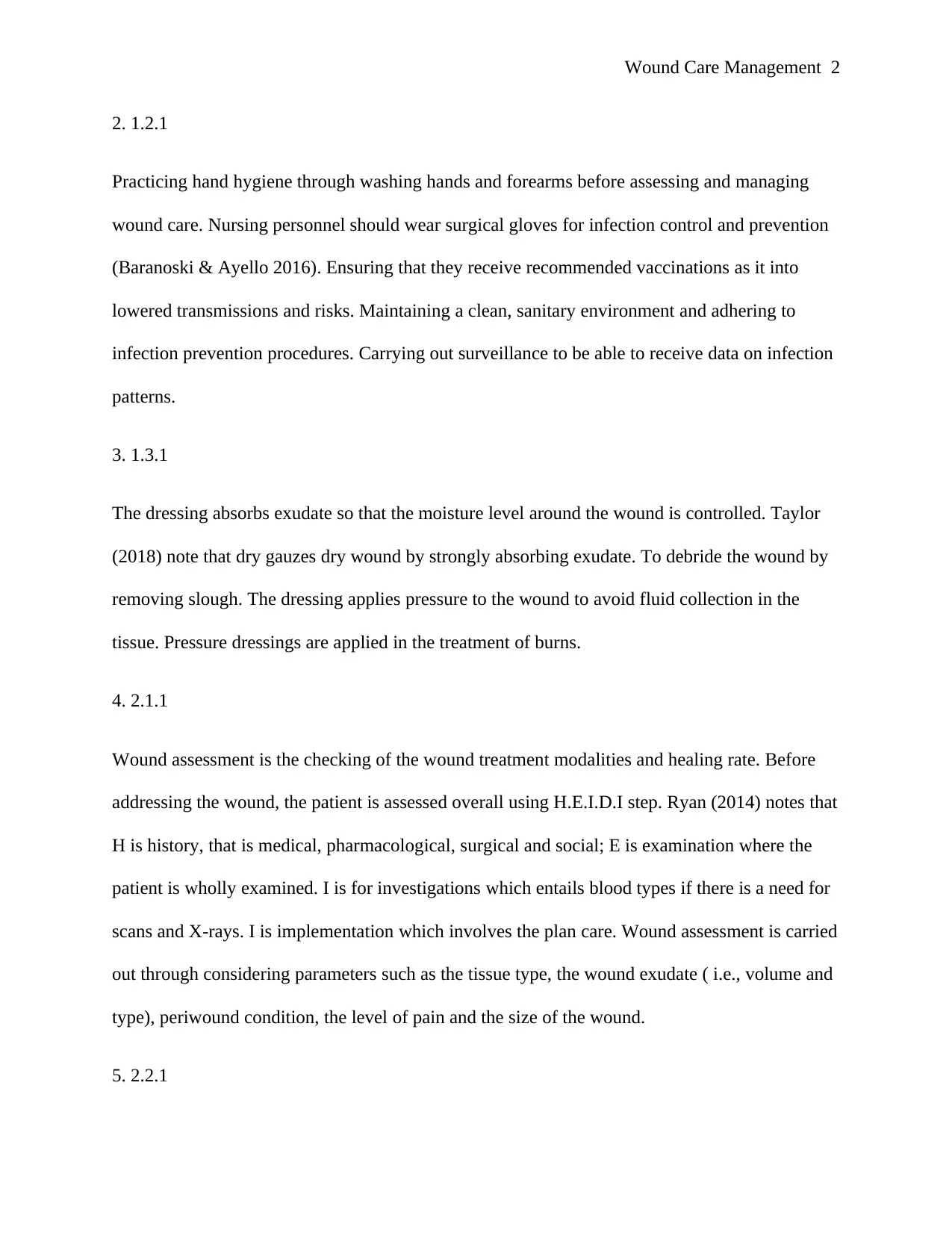
2. 1.2.1
Practicing hand hygiene through washing hands and forearms before assessing and managing
wound care. Nursing personnel should wear surgical gloves for infection control and prevention
(Baranoski & Ayello 2016). Ensuring that they receive recommended vaccinations as it into
lowered transmissions and risks. Maintaining a clean, sanitary environment and adhering to
infection prevention procedures. Carrying out surveillance to be able to receive data on infection
patterns.
3. 1.3.1
The dressing absorbs exudate so that the moisture level around the wound is controlled. Taylor
(2018) note that dry gauzes dry wound by strongly absorbing exudate. To debride the wound by
removing slough. The dressing applies pressure to the wound to avoid fluid collection in the
tissue. Pressure dressings are applied in the treatment of burns.
4. 2.1.1
Wound assessment is the checking of the wound treatment modalities and healing rate. Before
addressing the wound, the patient is assessed overall using H.E.I.D.I step. Ryan (2014) notes that
H is history, that is medical, pharmacological, surgical and social; E is examination where the
patient is wholly examined. I is for investigations which entails blood types if there is a need for
scans and X-rays. I is implementation which involves the plan care. Wound assessment is carried
out through considering parameters such as the tissue type, the wound exudate ( i.e., volume and
type), periwound condition, the level of pain and the size of the wound.
5. 2.2.1

A much slower healing process sometimes associated with pain is associated with patients who
suffer from depression and anxiety compared to those who have a positive attitude. Both
psychological and emotional considerations are felt in varied ways with patients nursing wounds
(Australian Wound Management Association 2010). The psychological considerations that affect
the wound come about due to experiences such as shame on the family burden, anxiety about
health and finance outcomes, grief due to change in body image, isolation from friends/ family
and depression on diminished quality of life.
6. 2.3.1
Wound infection is a complication in wounds that cause delayed healing and nurses have the
obligation and responsibility to determine the infection through carrying out wound bed
preparation that is effective through utilizing topical antimicrobials. Osteomyelitis is a chronic
wound that spreads to the underlying bone and tissues. Nurses are charged with ensuring that
such wounds are attended to through antibiotic therapy (Maani, Hoffman, Fowler, Maiers,
Gaylord & DeSocio 2011). With issues such as periwound dermatitis is skin damage linked to
moisture, the nurses are supposed to use dressing absorbent to handle exudate and use skin
sealants to prevent skin breakdown.
7. 2.4.1
I will first explain to the family, then family and patient that burn infection as the growth and
multiplication of microorganisms within the wound. I would describe that cross-infection is the
transfer of microorganisms between individuals and objects. The risks of infection include not
securing the dressing and incontinence. Management of the burn infection will entail treatment.
⊘ This is a preview!⊘
Do you want full access?
Subscribe today to unlock all pages.

Trusted by 1+ million students worldwide
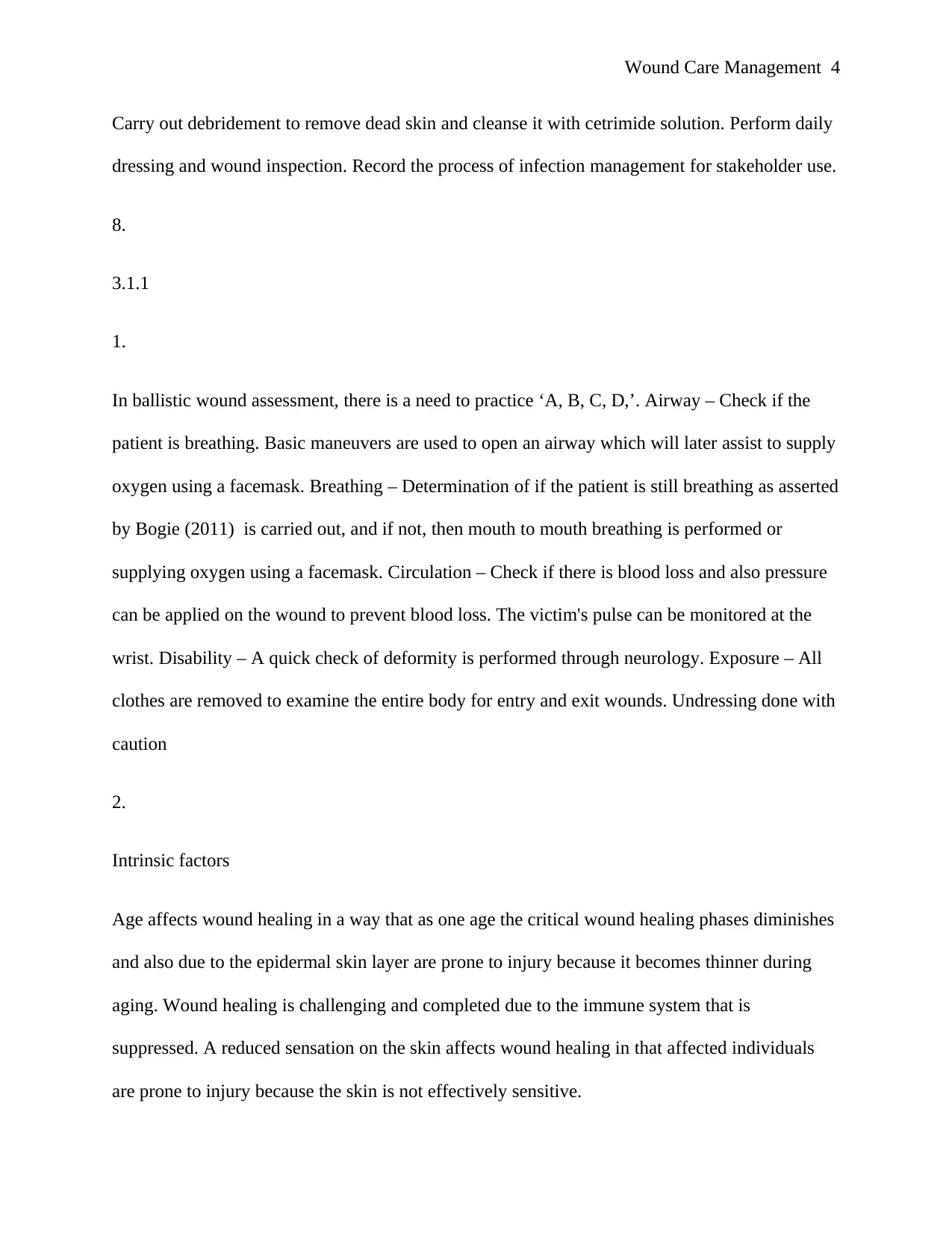
Carry out debridement to remove dead skin and cleanse it with cetrimide solution. Perform daily
dressing and wound inspection. Record the process of infection management for stakeholder use.
8.
3.1.1
1.
In ballistic wound assessment, there is a need to practice ‘A, B, C, D,’. Airway – Check if the
patient is breathing. Basic maneuvers are used to open an airway which will later assist to supply
oxygen using a facemask. Breathing – Determination of if the patient is still breathing as asserted
by Bogie (2011) is carried out, and if not, then mouth to mouth breathing is performed or
supplying oxygen using a facemask. Circulation – Check if there is blood loss and also pressure
can be applied on the wound to prevent blood loss. The victim's pulse can be monitored at the
wrist. Disability – A quick check of deformity is performed through neurology. Exposure – All
clothes are removed to examine the entire body for entry and exit wounds. Undressing done with
caution
2.
Intrinsic factors
Age affects wound healing in a way that as one age the critical wound healing phases diminishes
and also due to the epidermal skin layer are prone to injury because it becomes thinner during
aging. Wound healing is challenging and completed due to the immune system that is
suppressed. A reduced sensation on the skin affects wound healing in that affected individuals
are prone to injury because the skin is not effectively sensitive.
Paraphrase This Document
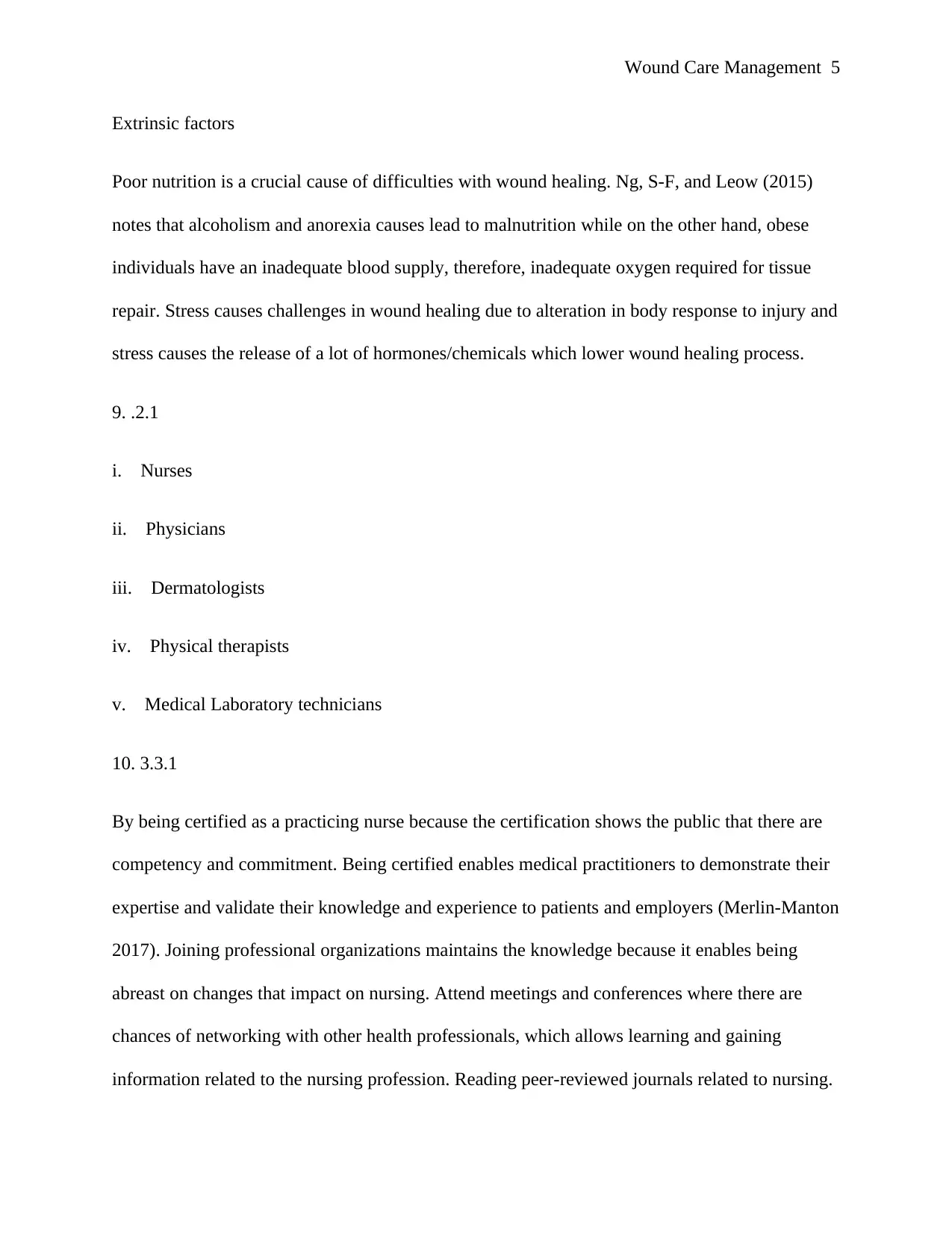
Extrinsic factors
Poor nutrition is a crucial cause of difficulties with wound healing. Ng, S-F, and Leow (2015)
notes that alcoholism and anorexia causes lead to malnutrition while on the other hand, obese
individuals have an inadequate blood supply, therefore, inadequate oxygen required for tissue
repair. Stress causes challenges in wound healing due to alteration in body response to injury and
stress causes the release of a lot of hormones/chemicals which lower wound healing process.
9. .2.1
i. Nurses
ii. Physicians
iii. Dermatologists
iv. Physical therapists
v. Medical Laboratory technicians
10. 3.3.1
By being certified as a practicing nurse because the certification shows the public that there are
competency and commitment. Being certified enables medical practitioners to demonstrate their
expertise and validate their knowledge and experience to patients and employers (Merlin-Manton
2017). Joining professional organizations maintains the knowledge because it enables being
abreast on changes that impact on nursing. Attend meetings and conferences where there are
chances of networking with other health professionals, which allows learning and gaining
information related to the nursing profession. Reading peer-reviewed journals related to nursing.
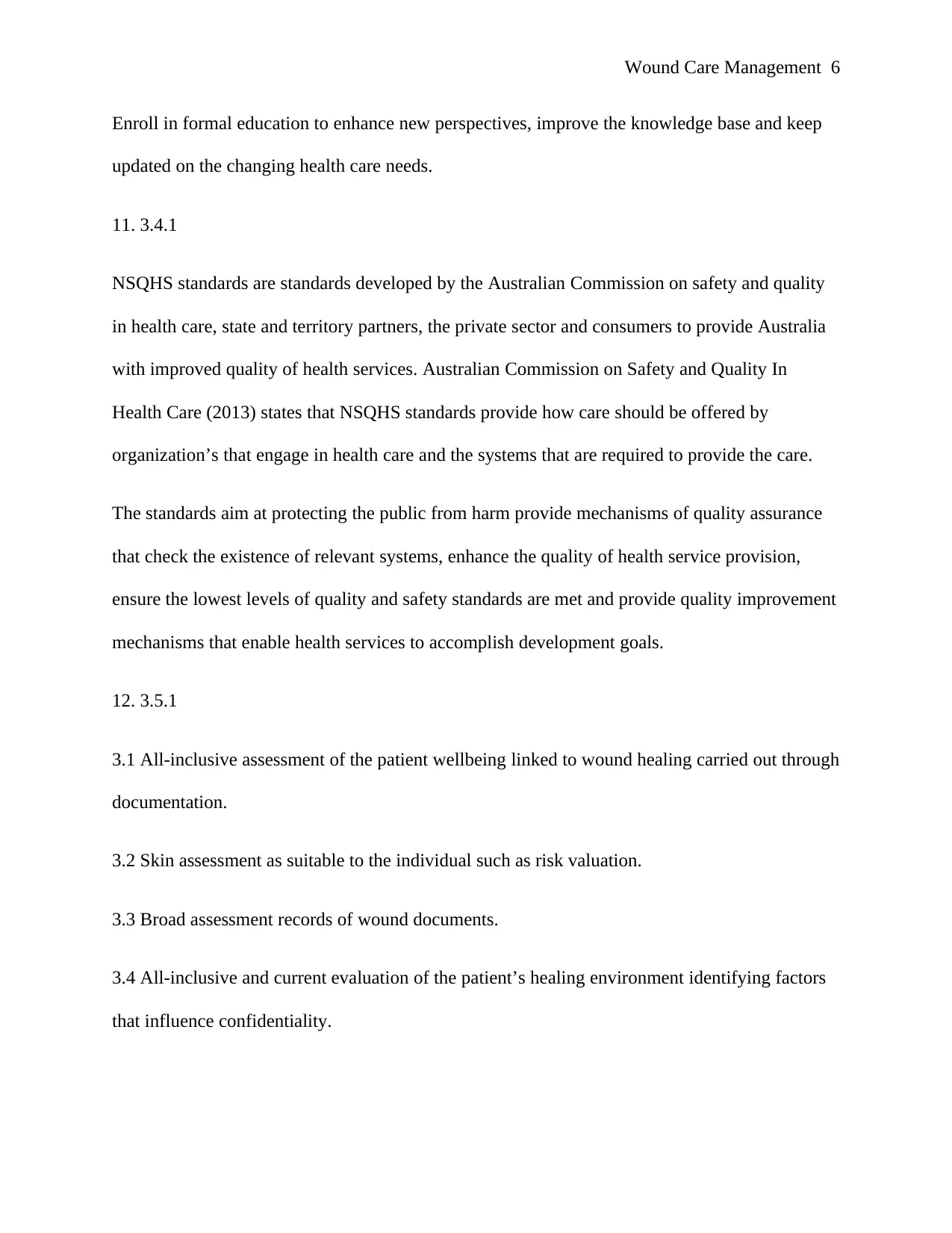
Enroll in formal education to enhance new perspectives, improve the knowledge base and keep
updated on the changing health care needs.
11. 3.4.1
NSQHS standards are standards developed by the Australian Commission on safety and quality
in health care, state and territory partners, the private sector and consumers to provide Australia
with improved quality of health services. Australian Commission on Safety and Quality In
Health Care (2013) states that NSQHS standards provide how care should be offered by
organization’s that engage in health care and the systems that are required to provide the care.
The standards aim at protecting the public from harm provide mechanisms of quality assurance
that check the existence of relevant systems, enhance the quality of health service provision,
ensure the lowest levels of quality and safety standards are met and provide quality improvement
mechanisms that enable health services to accomplish development goals.
12. 3.5.1
3.1 All-inclusive assessment of the patient wellbeing linked to wound healing carried out through
documentation.
3.2 Skin assessment as suitable to the individual such as risk valuation.
3.3 Broad assessment records of wound documents.
3.4 All-inclusive and current evaluation of the patient’s healing environment identifying factors
that influence confidentiality.
⊘ This is a preview!⊘
Do you want full access?
Subscribe today to unlock all pages.

Trusted by 1+ million students worldwide
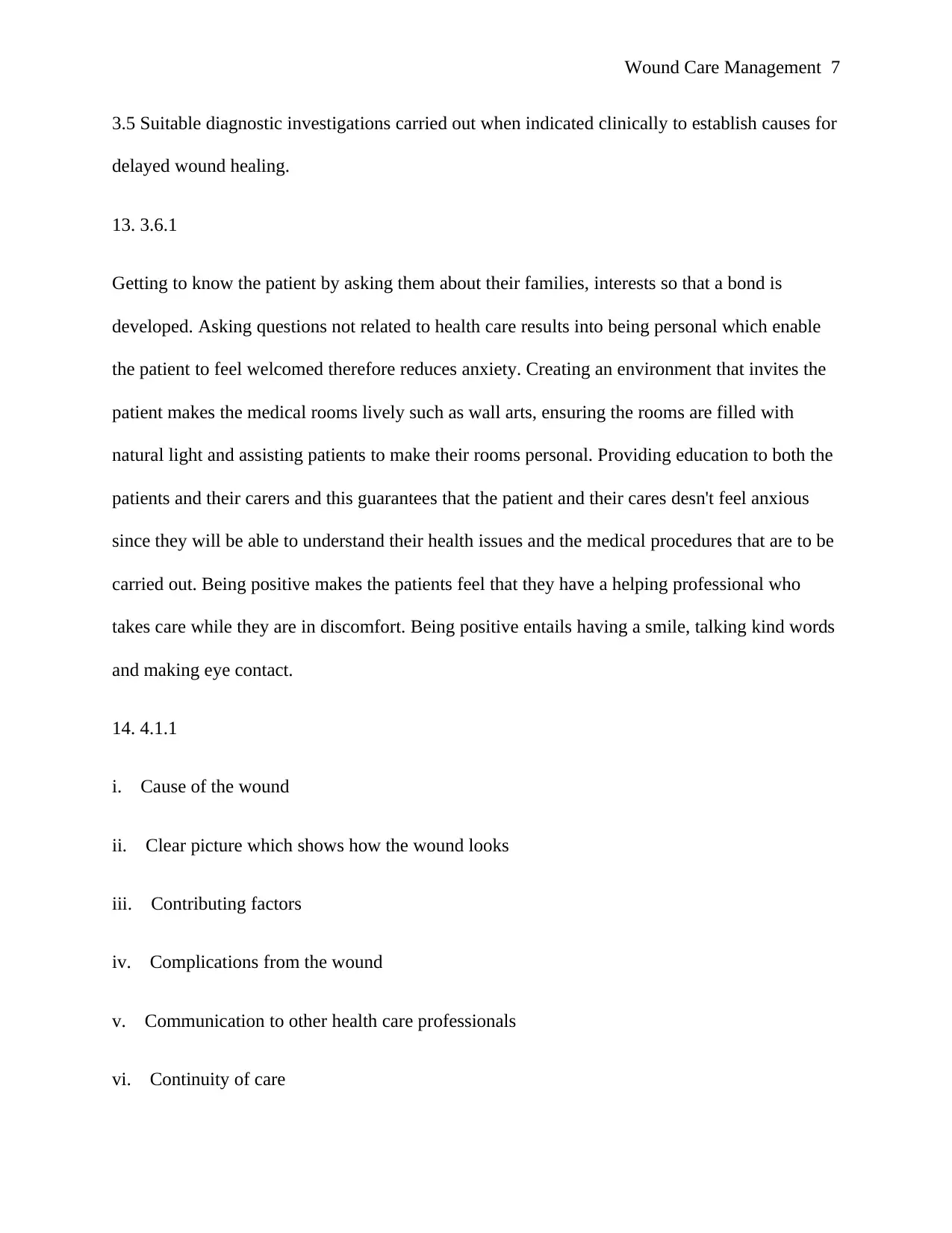
3.5 Suitable diagnostic investigations carried out when indicated clinically to establish causes for
delayed wound healing.
13. 3.6.1
Getting to know the patient by asking them about their families, interests so that a bond is
developed. Asking questions not related to health care results into being personal which enable
the patient to feel welcomed therefore reduces anxiety. Creating an environment that invites the
patient makes the medical rooms lively such as wall arts, ensuring the rooms are filled with
natural light and assisting patients to make their rooms personal. Providing education to both the
patients and their carers and this guarantees that the patient and their cares desn't feel anxious
since they will be able to understand their health issues and the medical procedures that are to be
carried out. Being positive makes the patients feel that they have a helping professional who
takes care while they are in discomfort. Being positive entails having a smile, talking kind words
and making eye contact.
14. 4.1.1
i. Cause of the wound
ii. Clear picture which shows how the wound looks
iii. Contributing factors
iv. Complications from the wound
v. Communication to other health care professionals
vi. Continuity of care
Paraphrase This Document
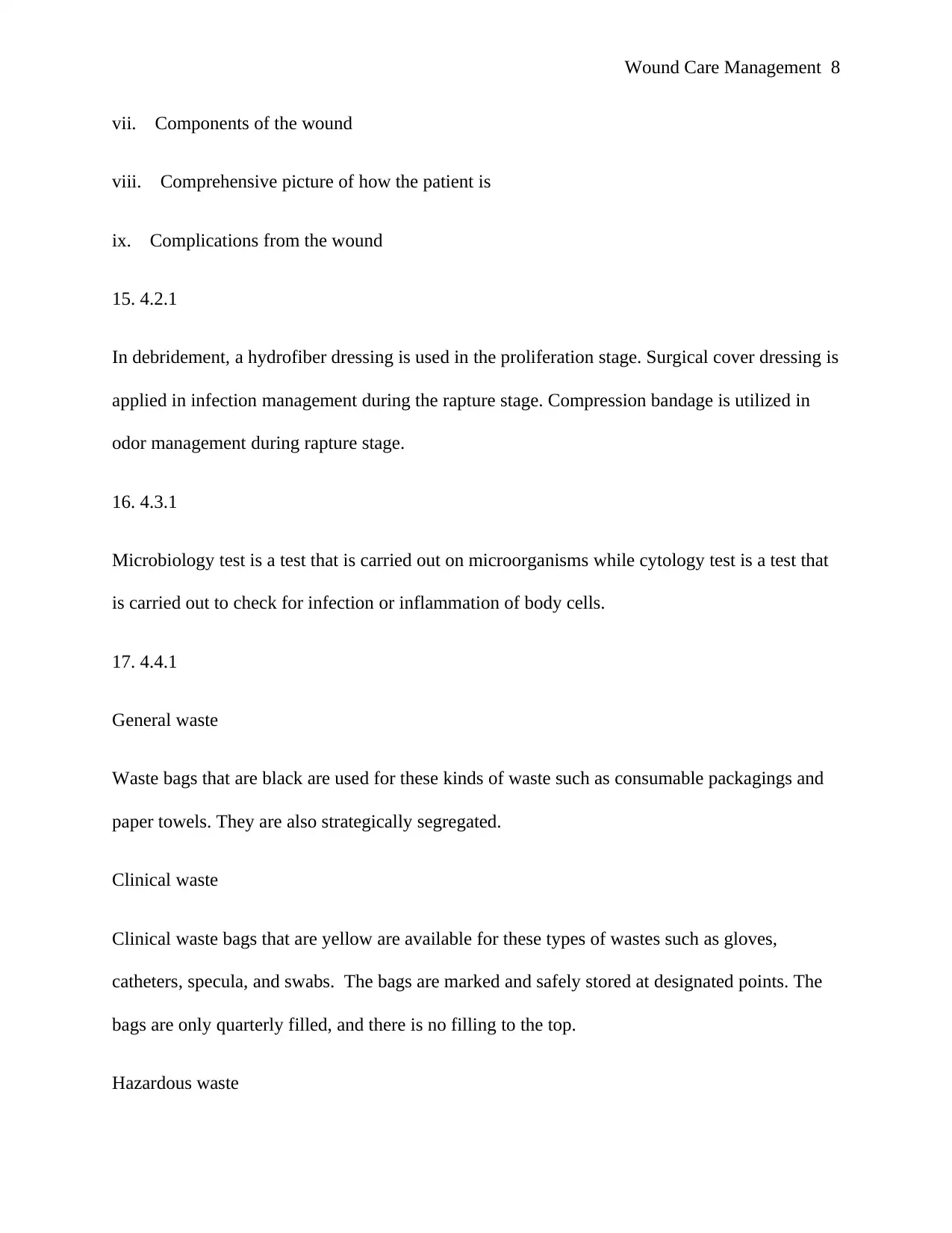
vii. Components of the wound
viii. Comprehensive picture of how the patient is
ix. Complications from the wound
15. 4.2.1
In debridement, a hydrofiber dressing is used in the proliferation stage. Surgical cover dressing is
applied in infection management during the rapture stage. Compression bandage is utilized in
odor management during rapture stage.
16. 4.3.1
Microbiology test is a test that is carried out on microorganisms while cytology test is a test that
is carried out to check for infection or inflammation of body cells.
17. 4.4.1
General waste
Waste bags that are black are used for these kinds of waste such as consumable packagings and
paper towels. They are also strategically segregated.
Clinical waste
Clinical waste bags that are yellow are available for these types of wastes such as gloves,
catheters, specula, and swabs. The bags are marked and safely stored at designated points. The
bags are only quarterly filled, and there is no filling to the top.
Hazardous waste
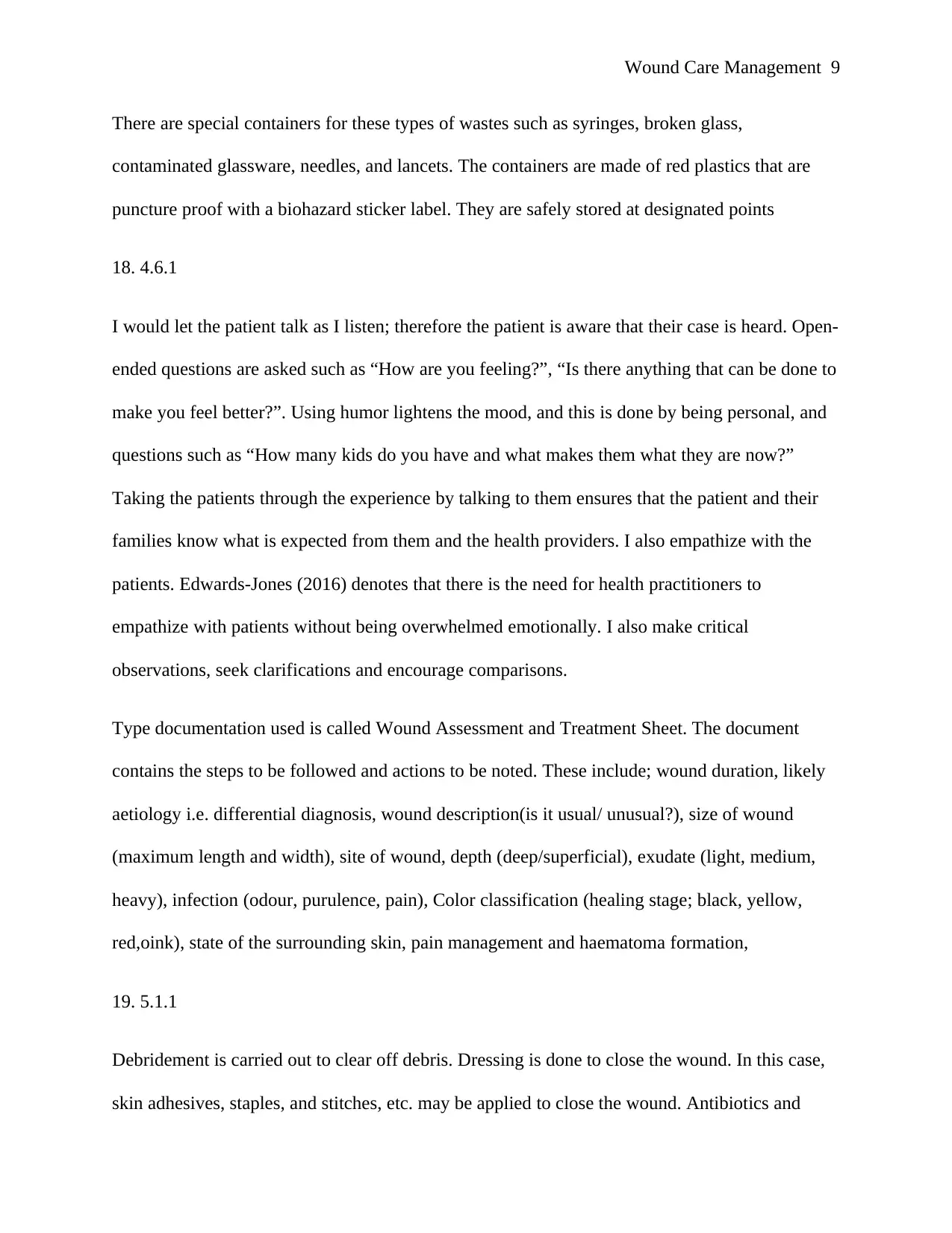
There are special containers for these types of wastes such as syringes, broken glass,
contaminated glassware, needles, and lancets. The containers are made of red plastics that are
puncture proof with a biohazard sticker label. They are safely stored at designated points
18. 4.6.1
I would let the patient talk as I listen; therefore the patient is aware that their case is heard. Open-
ended questions are asked such as “How are you feeling?”, “Is there anything that can be done to
make you feel better?”. Using humor lightens the mood, and this is done by being personal, and
questions such as “How many kids do you have and what makes them what they are now?”
Taking the patients through the experience by talking to them ensures that the patient and their
families know what is expected from them and the health providers. I also empathize with the
patients. Edwards-Jones (2016) denotes that there is the need for health practitioners to
empathize with patients without being overwhelmed emotionally. I also make critical
observations, seek clarifications and encourage comparisons.
Type documentation used is called Wound Assessment and Treatment Sheet. The document
contains the steps to be followed and actions to be noted. These include; wound duration, likely
aetiology i.e. differential diagnosis, wound description(is it usual/ unusual?), size of wound
(maximum length and width), site of wound, depth (deep/superficial), exudate (light, medium,
heavy), infection (odour, purulence, pain), Color classification (healing stage; black, yellow,
red,oink), state of the surrounding skin, pain management and haematoma formation,
19. 5.1.1
Debridement is carried out to clear off debris. Dressing is done to close the wound. In this case,
skin adhesives, staples, and stitches, etc. may be applied to close the wound. Antibiotics and
⊘ This is a preview!⊘
Do you want full access?
Subscribe today to unlock all pages.

Trusted by 1+ million students worldwide
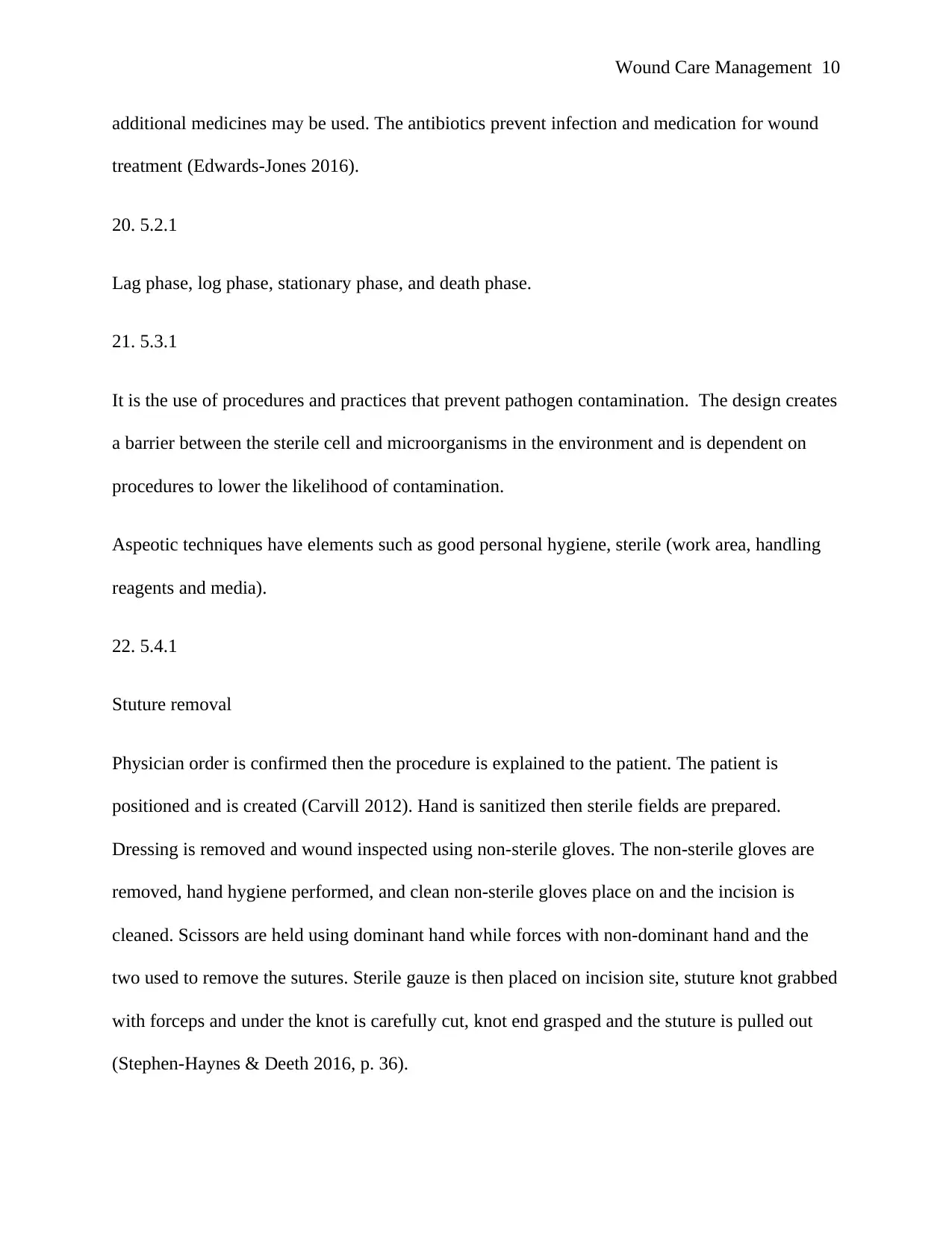
additional medicines may be used. The antibiotics prevent infection and medication for wound
treatment (Edwards-Jones 2016).
20. 5.2.1
Lag phase, log phase, stationary phase, and death phase.
21. 5.3.1
It is the use of procedures and practices that prevent pathogen contamination. The design creates
a barrier between the sterile cell and microorganisms in the environment and is dependent on
procedures to lower the likelihood of contamination.
Aspeotic techniques have elements such as good personal hygiene, sterile (work area, handling
reagents and media).
22. 5.4.1
Stuture removal
Physician order is confirmed then the procedure is explained to the patient. The patient is
positioned and is created (Carvill 2012). Hand is sanitized then sterile fields are prepared.
Dressing is removed and wound inspected using non-sterile gloves. The non-sterile gloves are
removed, hand hygiene performed, and clean non-sterile gloves place on and the incision is
cleaned. Scissors are held using dominant hand while forces with non-dominant hand and the
two used to remove the sutures. Sterile gauze is then placed on incision site, stuture knot grabbed
with forceps and under the knot is carefully cut, knot end grasped and the stuture is pulled out
(Stephen-Haynes & Deeth 2016, p. 36).
Paraphrase This Document
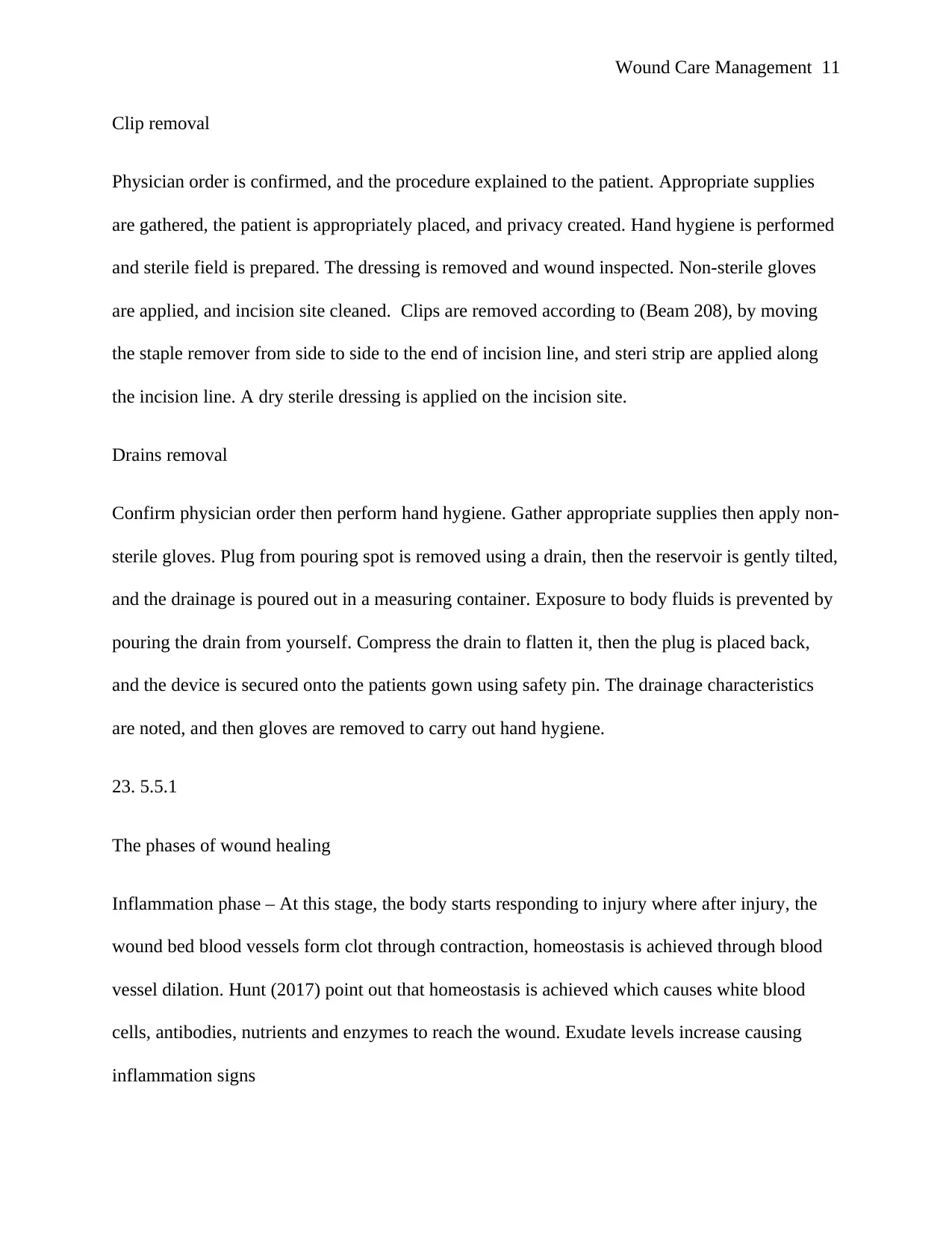
Clip removal
Physician order is confirmed, and the procedure explained to the patient. Appropriate supplies
are gathered, the patient is appropriately placed, and privacy created. Hand hygiene is performed
and sterile field is prepared. The dressing is removed and wound inspected. Non-sterile gloves
are applied, and incision site cleaned. Clips are removed according to (Beam 208), by moving
the staple remover from side to side to the end of incision line, and steri strip are applied along
the incision line. A dry sterile dressing is applied on the incision site.
Drains removal
Confirm physician order then perform hand hygiene. Gather appropriate supplies then apply non-
sterile gloves. Plug from pouring spot is removed using a drain, then the reservoir is gently tilted,
and the drainage is poured out in a measuring container. Exposure to body fluids is prevented by
pouring the drain from yourself. Compress the drain to flatten it, then the plug is placed back,
and the device is secured onto the patients gown using safety pin. The drainage characteristics
are noted, and then gloves are removed to carry out hand hygiene.
23. 5.5.1
The phases of wound healing
Inflammation phase – At this stage, the body starts responding to injury where after injury, the
wound bed blood vessels form clot through contraction, homeostasis is achieved through blood
vessel dilation. Hunt (2017) point out that homeostasis is achieved which causes white blood
cells, antibodies, nutrients and enzymes to reach the wound. Exudate levels increase causing
inflammation signs
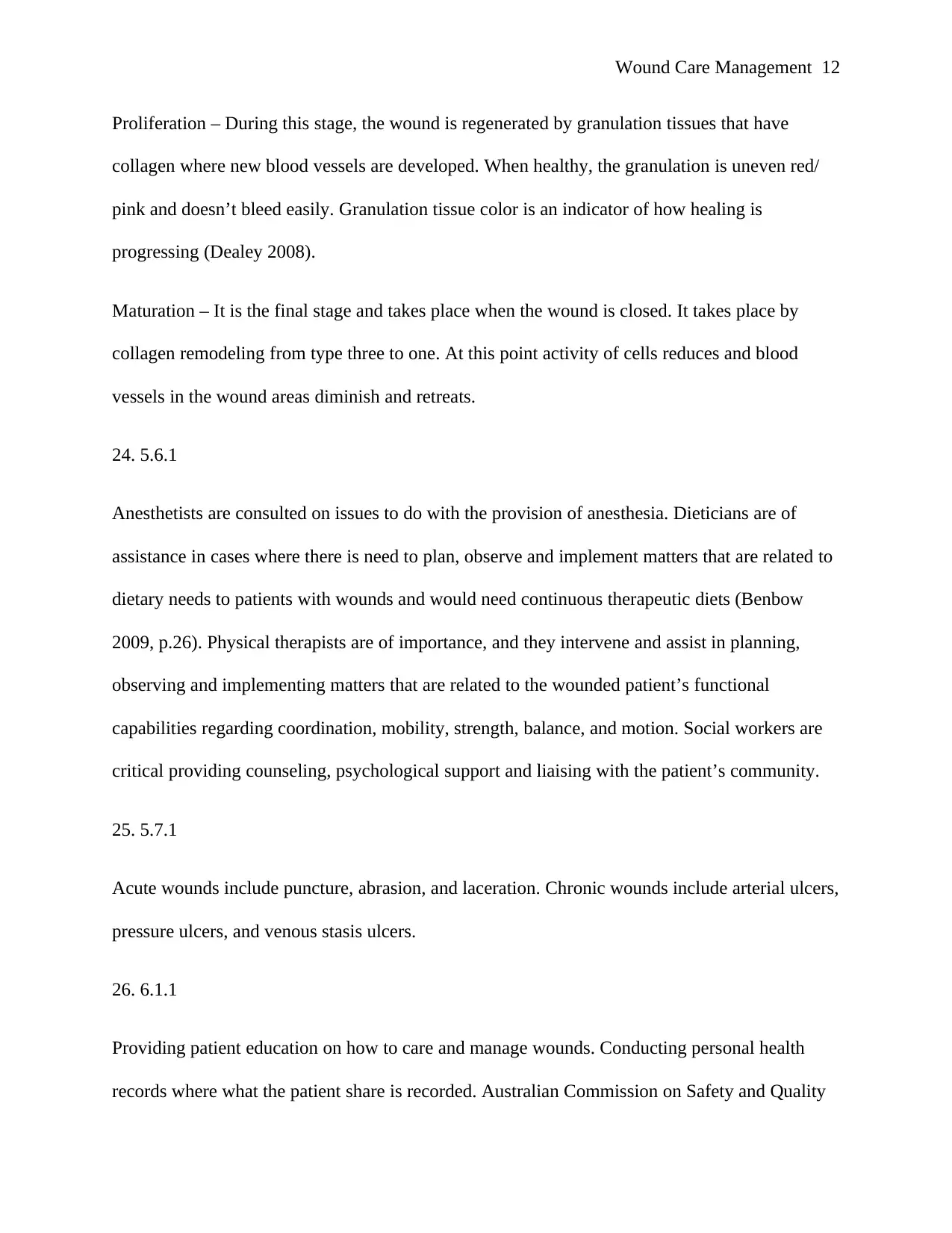
Proliferation – During this stage, the wound is regenerated by granulation tissues that have
collagen where new blood vessels are developed. When healthy, the granulation is uneven red/
pink and doesn’t bleed easily. Granulation tissue color is an indicator of how healing is
progressing (Dealey 2008).
Maturation – It is the final stage and takes place when the wound is closed. It takes place by
collagen remodeling from type three to one. At this point activity of cells reduces and blood
vessels in the wound areas diminish and retreats.
24. 5.6.1
Anesthetists are consulted on issues to do with the provision of anesthesia. Dieticians are of
assistance in cases where there is need to plan, observe and implement matters that are related to
dietary needs to patients with wounds and would need continuous therapeutic diets (Benbow
2009, p.26). Physical therapists are of importance, and they intervene and assist in planning,
observing and implementing matters that are related to the wounded patient’s functional
capabilities regarding coordination, mobility, strength, balance, and motion. Social workers are
critical providing counseling, psychological support and liaising with the patient’s community.
25. 5.7.1
Acute wounds include puncture, abrasion, and laceration. Chronic wounds include arterial ulcers,
pressure ulcers, and venous stasis ulcers.
26. 6.1.1
Providing patient education on how to care and manage wounds. Conducting personal health
records where what the patient share is recorded. Australian Commission on Safety and Quality
⊘ This is a preview!⊘
Do you want full access?
Subscribe today to unlock all pages.

Trusted by 1+ million students worldwide
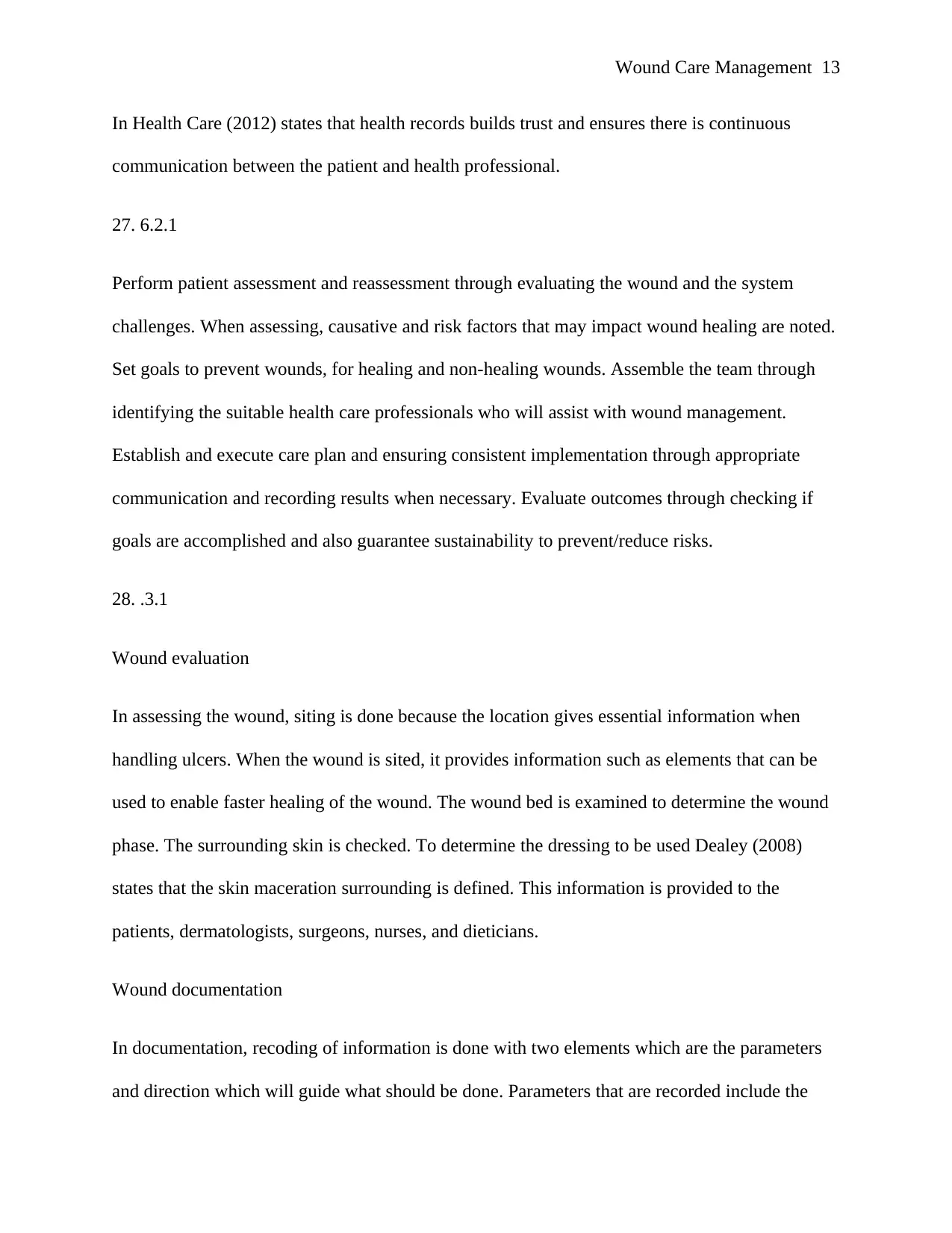
In Health Care (2012) states that health records builds trust and ensures there is continuous
communication between the patient and health professional.
27. 6.2.1
Perform patient assessment and reassessment through evaluating the wound and the system
challenges. When assessing, causative and risk factors that may impact wound healing are noted.
Set goals to prevent wounds, for healing and non-healing wounds. Assemble the team through
identifying the suitable health care professionals who will assist with wound management.
Establish and execute care plan and ensuring consistent implementation through appropriate
communication and recording results when necessary. Evaluate outcomes through checking if
goals are accomplished and also guarantee sustainability to prevent/reduce risks.
28. .3.1
Wound evaluation
In assessing the wound, siting is done because the location gives essential information when
handling ulcers. When the wound is sited, it provides information such as elements that can be
used to enable faster healing of the wound. The wound bed is examined to determine the wound
phase. The surrounding skin is checked. To determine the dressing to be used Dealey (2008)
states that the skin maceration surrounding is defined. This information is provided to the
patients, dermatologists, surgeons, nurses, and dieticians.
Wound documentation
In documentation, recoding of information is done with two elements which are the parameters
and direction which will guide what should be done. Parameters that are recorded include the
Paraphrase This Document
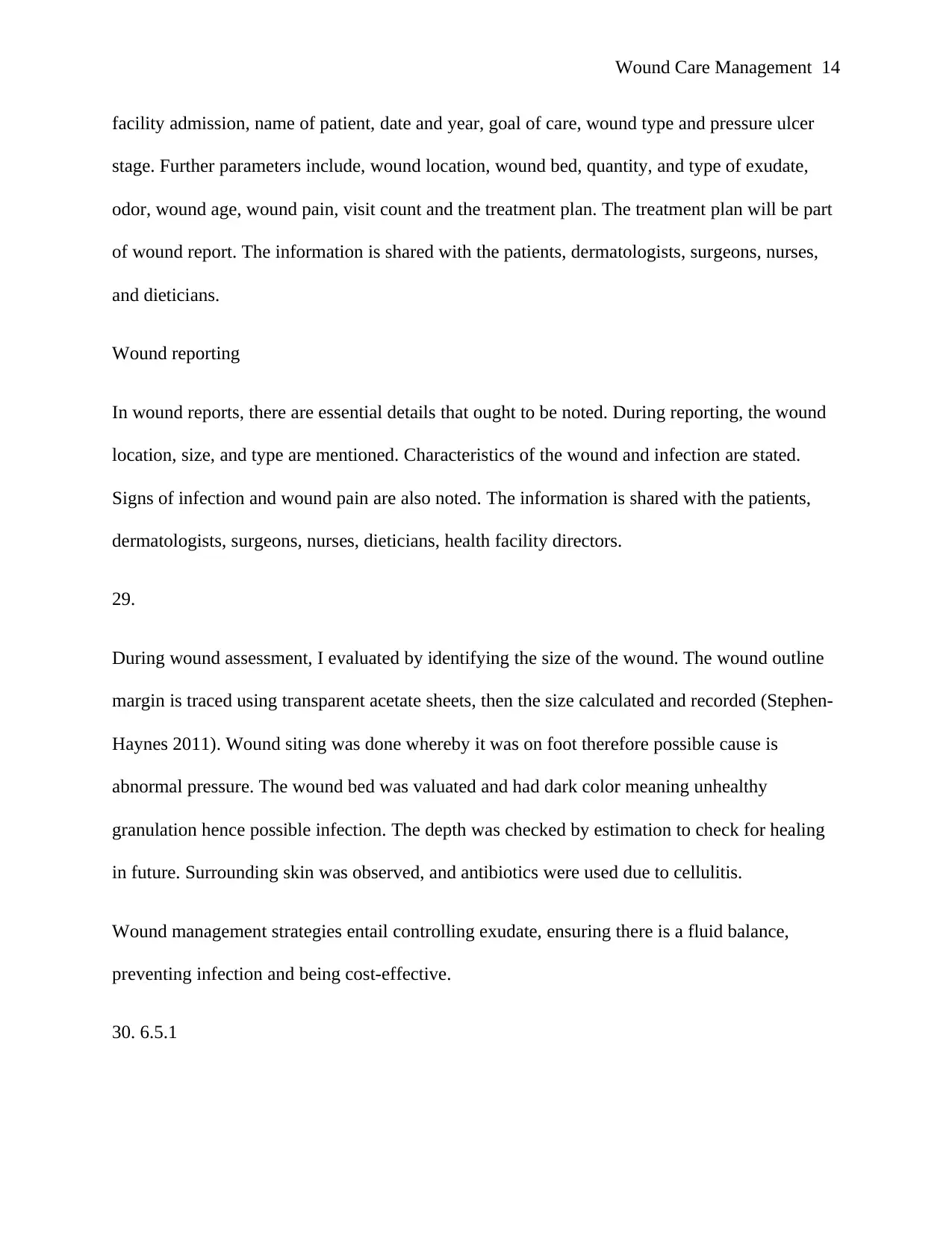
facility admission, name of patient, date and year, goal of care, wound type and pressure ulcer
stage. Further parameters include, wound location, wound bed, quantity, and type of exudate,
odor, wound age, wound pain, visit count and the treatment plan. The treatment plan will be part
of wound report. The information is shared with the patients, dermatologists, surgeons, nurses,
and dieticians.
Wound reporting
In wound reports, there are essential details that ought to be noted. During reporting, the wound
location, size, and type are mentioned. Characteristics of the wound and infection are stated.
Signs of infection and wound pain are also noted. The information is shared with the patients,
dermatologists, surgeons, nurses, dieticians, health facility directors.
29.
During wound assessment, I evaluated by identifying the size of the wound. The wound outline
margin is traced using transparent acetate sheets, then the size calculated and recorded (Stephen-
Haynes 2011). Wound siting was done whereby it was on foot therefore possible cause is
abnormal pressure. The wound bed was valuated and had dark color meaning unhealthy
granulation hence possible infection. The depth was checked by estimation to check for healing
in future. Surrounding skin was observed, and antibiotics were used due to cellulitis.
Wound management strategies entail controlling exudate, ensuring there is a fluid balance,
preventing infection and being cost-effective.
30. 6.5.1
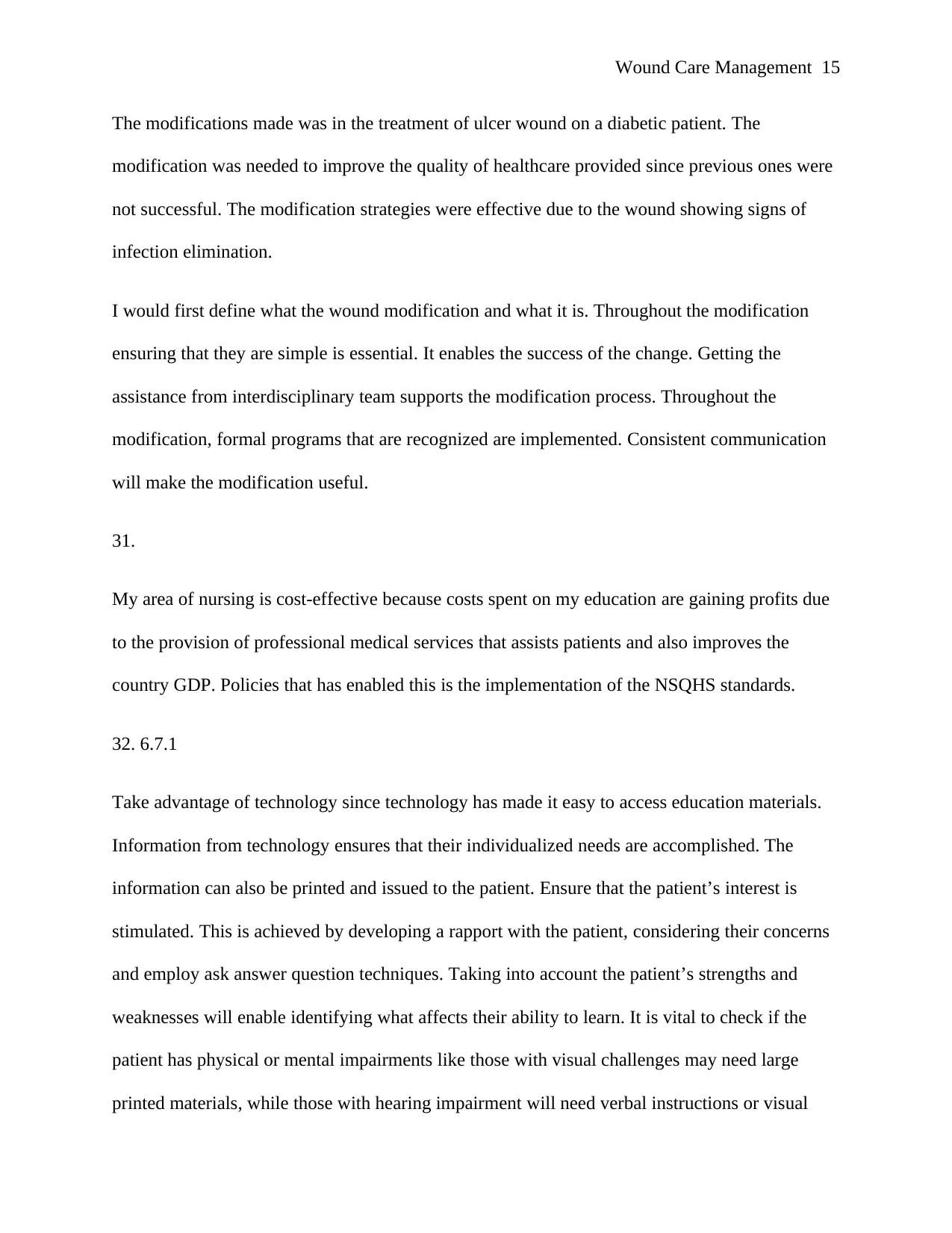
The modifications made was in the treatment of ulcer wound on a diabetic patient. The
modification was needed to improve the quality of healthcare provided since previous ones were
not successful. The modification strategies were effective due to the wound showing signs of
infection elimination.
I would first define what the wound modification and what it is. Throughout the modification
ensuring that they are simple is essential. It enables the success of the change. Getting the
assistance from interdisciplinary team supports the modification process. Throughout the
modification, formal programs that are recognized are implemented. Consistent communication
will make the modification useful.
31.
My area of nursing is cost-effective because costs spent on my education are gaining profits due
to the provision of professional medical services that assists patients and also improves the
country GDP. Policies that has enabled this is the implementation of the NSQHS standards.
32. 6.7.1
Take advantage of technology since technology has made it easy to access education materials.
Information from technology ensures that their individualized needs are accomplished. The
information can also be printed and issued to the patient. Ensure that the patient’s interest is
stimulated. This is achieved by developing a rapport with the patient, considering their concerns
and employ ask answer question techniques. Taking into account the patient’s strengths and
weaknesses will enable identifying what affects their ability to learn. It is vital to check if the
patient has physical or mental impairments like those with visual challenges may need large
printed materials, while those with hearing impairment will need verbal instructions or visual
⊘ This is a preview!⊘
Do you want full access?
Subscribe today to unlock all pages.

Trusted by 1+ million students worldwide
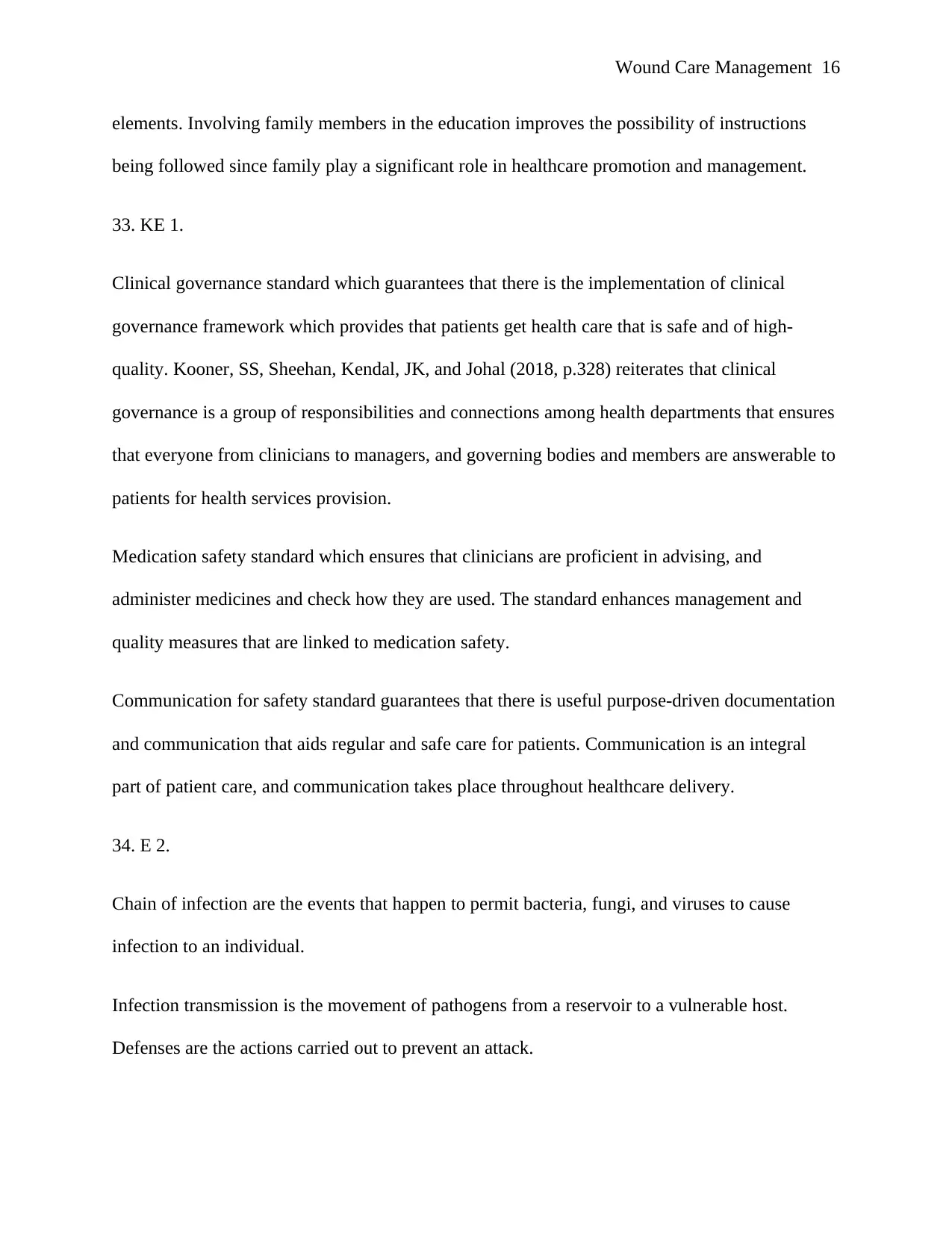
elements. Involving family members in the education improves the possibility of instructions
being followed since family play a significant role in healthcare promotion and management.
33. KE 1.
Clinical governance standard which guarantees that there is the implementation of clinical
governance framework which provides that patients get health care that is safe and of high-
quality. Kooner, SS, Sheehan, Kendal, JK, and Johal (2018, p.328) reiterates that clinical
governance is a group of responsibilities and connections among health departments that ensures
that everyone from clinicians to managers, and governing bodies and members are answerable to
patients for health services provision.
Medication safety standard which ensures that clinicians are proficient in advising, and
administer medicines and check how they are used. The standard enhances management and
quality measures that are linked to medication safety.
Communication for safety standard guarantees that there is useful purpose-driven documentation
and communication that aids regular and safe care for patients. Communication is an integral
part of patient care, and communication takes place throughout healthcare delivery.
34. E 2.
Chain of infection are the events that happen to permit bacteria, fungi, and viruses to cause
infection to an individual.
Infection transmission is the movement of pathogens from a reservoir to a vulnerable host.
Defenses are the actions carried out to prevent an attack.
Paraphrase This Document
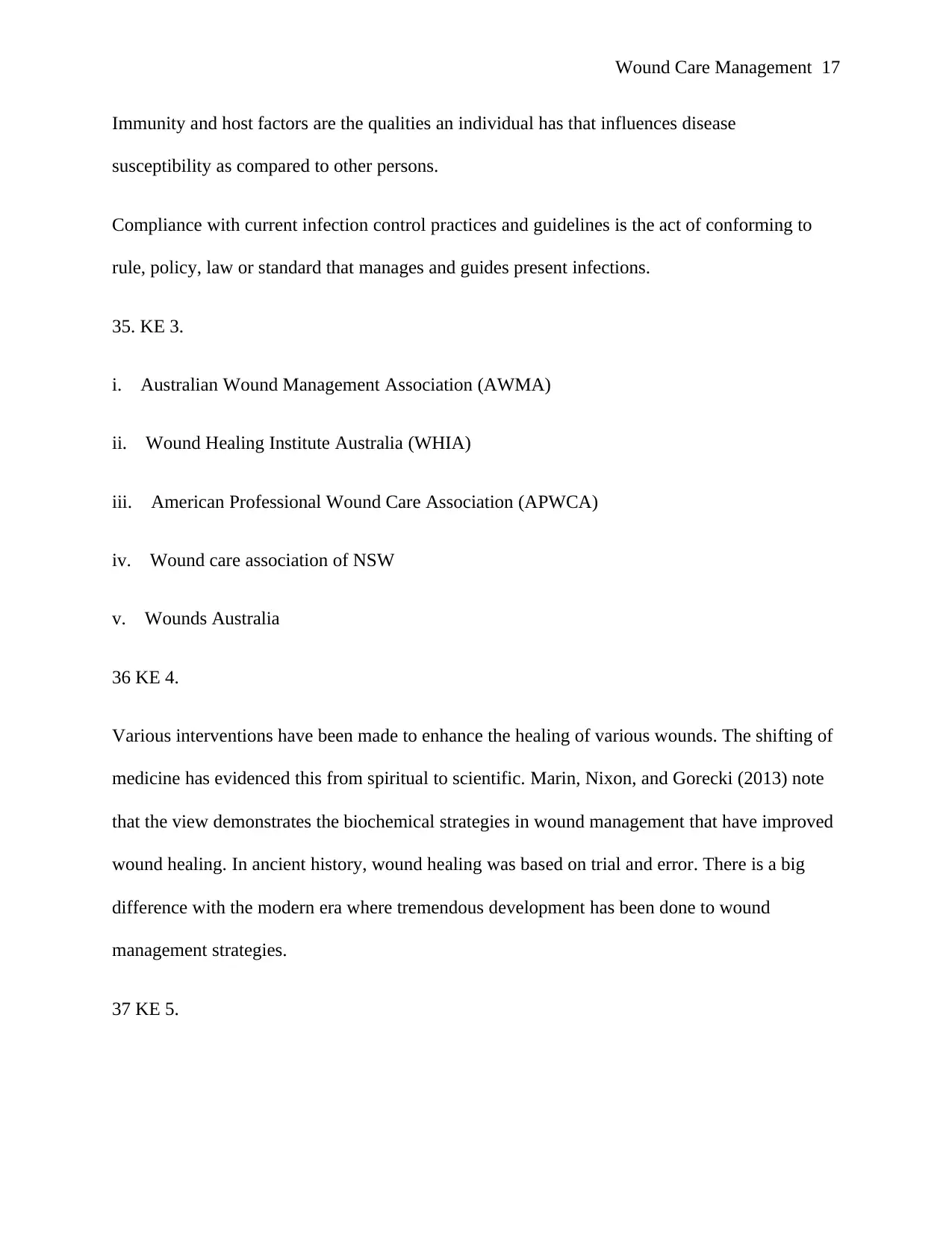
Immunity and host factors are the qualities an individual has that influences disease
susceptibility as compared to other persons.
Compliance with current infection control practices and guidelines is the act of conforming to
rule, policy, law or standard that manages and guides present infections.
35. KE 3.
i. Australian Wound Management Association (AWMA)
ii. Wound Healing Institute Australia (WHIA)
iii. American Professional Wound Care Association (APWCA)
iv. Wound care association of NSW
v. Wounds Australia
36 KE 4.
Various interventions have been made to enhance the healing of various wounds. The shifting of
medicine has evidenced this from spiritual to scientific. Marin, Nixon, and Gorecki (2013) note
that the view demonstrates the biochemical strategies in wound management that have improved
wound healing. In ancient history, wound healing was based on trial and error. There is a big
difference with the modern era where tremendous development has been done to wound
management strategies.
37 KE 5.
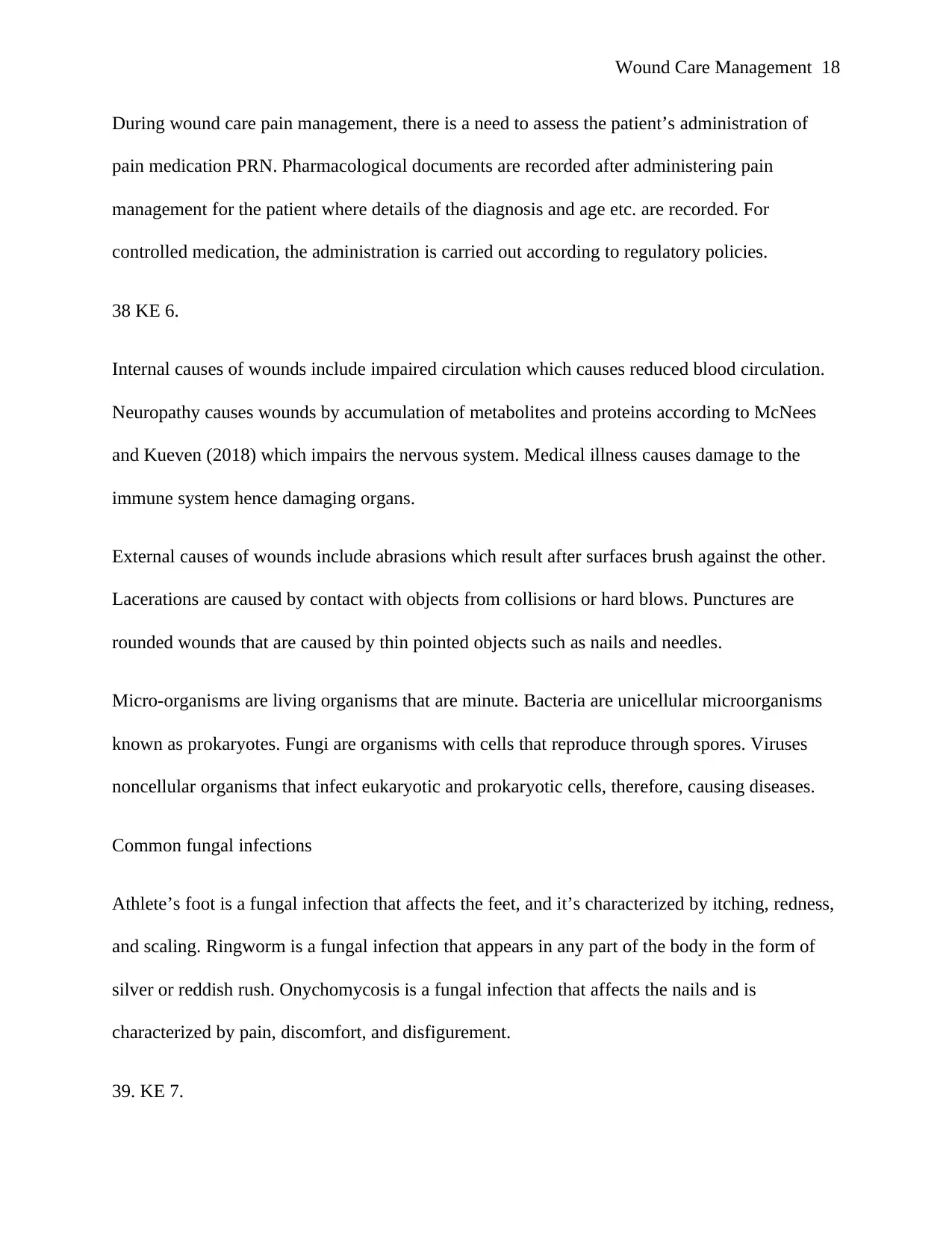
During wound care pain management, there is a need to assess the patient’s administration of
pain medication PRN. Pharmacological documents are recorded after administering pain
management for the patient where details of the diagnosis and age etc. are recorded. For
controlled medication, the administration is carried out according to regulatory policies.
38 KE 6.
Internal causes of wounds include impaired circulation which causes reduced blood circulation.
Neuropathy causes wounds by accumulation of metabolites and proteins according to McNees
and Kueven (2018) which impairs the nervous system. Medical illness causes damage to the
immune system hence damaging organs.
External causes of wounds include abrasions which result after surfaces brush against the other.
Lacerations are caused by contact with objects from collisions or hard blows. Punctures are
rounded wounds that are caused by thin pointed objects such as nails and needles.
Micro-organisms are living organisms that are minute. Bacteria are unicellular microorganisms
known as prokaryotes. Fungi are organisms with cells that reproduce through spores. Viruses
noncellular organisms that infect eukaryotic and prokaryotic cells, therefore, causing diseases.
Common fungal infections
Athlete’s foot is a fungal infection that affects the feet, and it’s characterized by itching, redness,
and scaling. Ringworm is a fungal infection that appears in any part of the body in the form of
silver or reddish rush. Onychomycosis is a fungal infection that affects the nails and is
characterized by pain, discomfort, and disfigurement.
39. KE 7.
⊘ This is a preview!⊘
Do you want full access?
Subscribe today to unlock all pages.

Trusted by 1+ million students worldwide

i. Edema
ii. Autolysis
iii. Extracellular Matrix
iv. Haemostasis
v. Neuroischaemia
40.
• Wound debridement is the removal of tissues that are unhealthy from a wound to enhance
healing.
• Wound drains are devices used to extract blood and other fluids from a wound while wound
drainage systems are features of surgical wound management carried out post-operation to
eliminate drainage from a wound bed to avert infection and wound healing delay.
• Wound specimen collection is the process carried out to obtain cultures from wound to be
used to perform specific tests.
• Interpreting laboratory results in consultation with a registered nurse or interdisciplinary team
is the use of a coordinated group of medical experts to deduce laboratory test information.
• Doppler assessment is the use of high-frequency sound waves to check the quantity of blood
flow in a wound
• Compression therapy is the process of enhancing blood flow in the lower limbs by firming up
vein support.
Paraphrase This Document

• Wound cleansing techniques are the procedures carried out by use of fluids to remove loosely
adherent contaminants in a tender manner from a wound surface.
• Wound measurement is a wound assessment process whereby the wound size is determined
to check wound healing progress.
• Clinical photography is the recording of medical conditions presented by patients using
cameras to aid in diagnosis during treatment.
• Wound tracing is a technique that is two-dimensional, used for recording wound area
41. E 9.
Explain using your own words the following acute and chronic wounds:
• Surgical wound is an incision made on the skin during surgery.
• Pressure ulcers are injuries on the skin and tissues that are caused by elongated pressure on
the skin.
• Venous ulcers are injuries caused due to an abnormality in vein function.
• Arterial ulcers are sores that result due to poor perfusion.
• Mixed ulcers are sores caused by arterial insufficiency.
• Discharging wounds are wounds that produce exudate.
• Malignant wounds are sours caused due to infiltration of cancerous cells into the skin, lymph
and blood vessels leading to the death of tissues.

• Neuropathic ulceration wounds are sores that form as a result of peripheral neuropathy,
especially in diabetic patients.
• Infected wounds are wounds that have microorganism invasion resulting in tissue damage
and cell injury.
• Burns are the damage of skin cells when the skin comes into contact with a hot object.
• Fistula is an anomalous pathway that leads from an internal organ to the body surface, and
sinuses is a tract that in anomalous and ends in an opening.
• Skin grafts are skins that are removed from one part of the body to a different part.
• Visceral wounds are injuries that take place around the internal organs around the chest or
abdomen.
42. KE 10.
Provide details about the wound management strategies listed below:
• Wound management principles
• Moist wound healing is a technique whereby the wound is kept in an environment that is
optically moist to enhance faster healing. It enables facilitation od analytic bederinment and
lowers wound infection.
• Holistic assessment is whereby a health professional valuates the patient in al sub-domains
and domains such as physical, mental emotional spiritual, social, sexual, environmental and
cultural needs of a patient. It saves on time and reduce cost.
⊘ This is a preview!⊘
Do you want full access?
Subscribe today to unlock all pages.

Trusted by 1+ million students worldwide
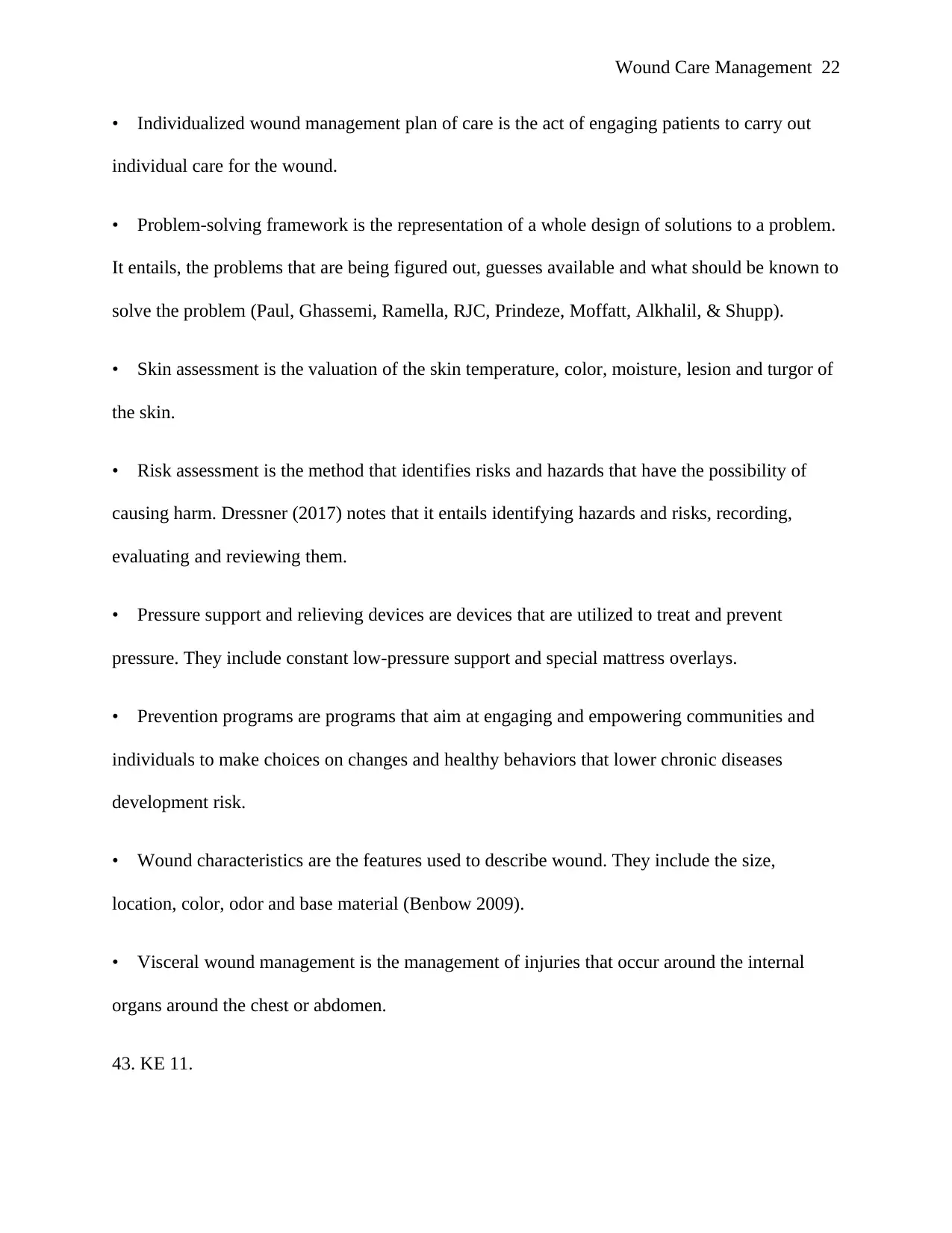
• Individualized wound management plan of care is the act of engaging patients to carry out
individual care for the wound.
• Problem-solving framework is the representation of a whole design of solutions to a problem.
It entails, the problems that are being figured out, guesses available and what should be known to
solve the problem (Paul, Ghassemi, Ramella, RJC, Prindeze, Moffatt, Alkhalil, & Shupp).
• Skin assessment is the valuation of the skin temperature, color, moisture, lesion and turgor of
the skin.
• Risk assessment is the method that identifies risks and hazards that have the possibility of
causing harm. Dressner (2017) notes that it entails identifying hazards and risks, recording,
evaluating and reviewing them.
• Pressure support and relieving devices are devices that are utilized to treat and prevent
pressure. They include constant low-pressure support and special mattress overlays.
• Prevention programs are programs that aim at engaging and empowering communities and
individuals to make choices on changes and healthy behaviors that lower chronic diseases
development risk.
• Wound characteristics are the features used to describe wound. They include the size,
location, color, odor and base material (Benbow 2009).
• Visceral wound management is the management of injuries that occur around the internal
organs around the chest or abdomen.
43. KE 11.
Paraphrase This Document
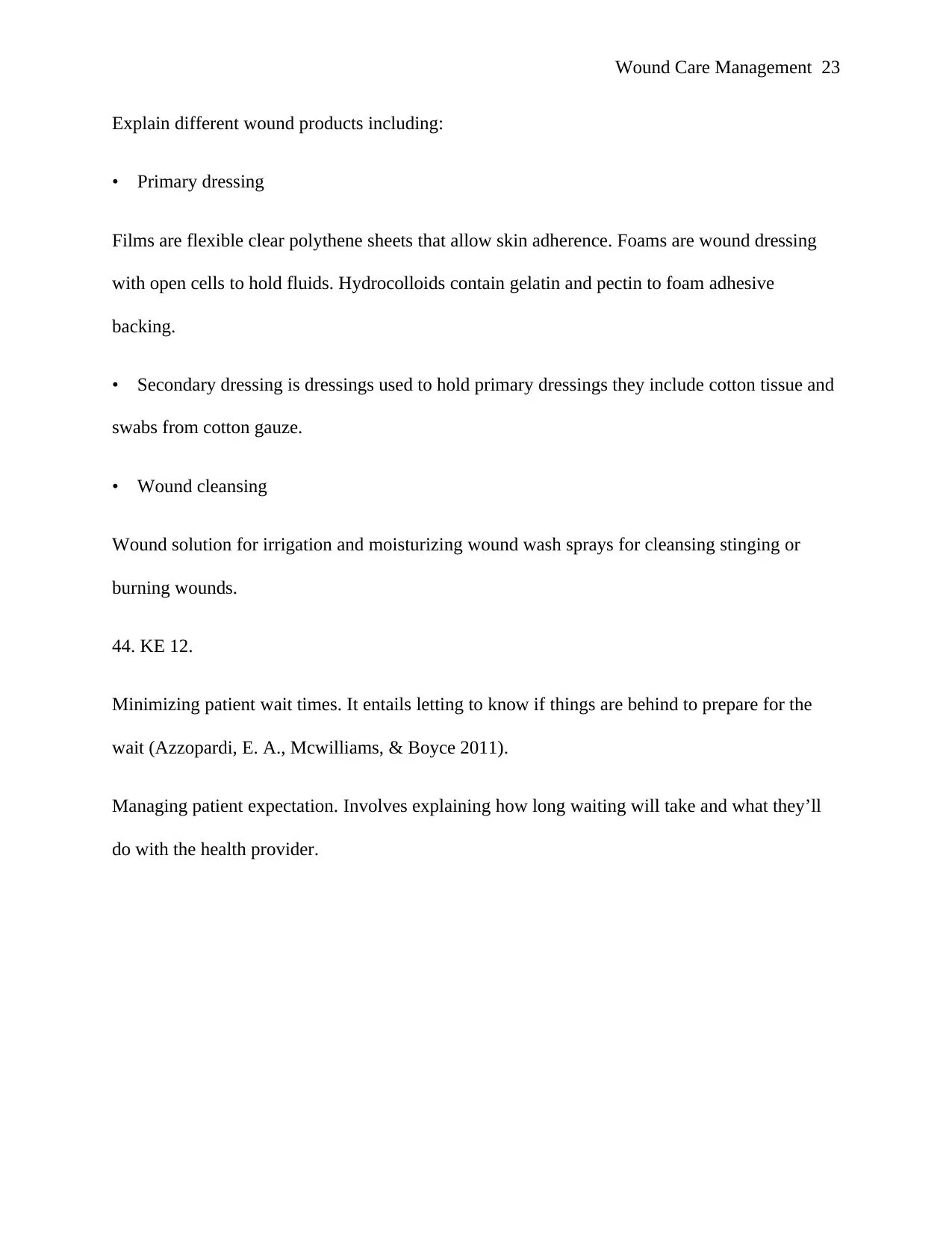
Explain different wound products including:
• Primary dressing
Films are flexible clear polythene sheets that allow skin adherence. Foams are wound dressing
with open cells to hold fluids. Hydrocolloids contain gelatin and pectin to foam adhesive
backing.
• Secondary dressing is dressings used to hold primary dressings they include cotton tissue and
swabs from cotton gauze.
• Wound cleansing
Wound solution for irrigation and moisturizing wound wash sprays for cleansing stinging or
burning wounds.
44. KE 12.
Minimizing patient wait times. It entails letting to know if things are behind to prepare for the
wait (Azzopardi, E. A., Mcwilliams, & Boyce 2011).
Managing patient expectation. Involves explaining how long waiting will take and what they’ll
do with the health provider.
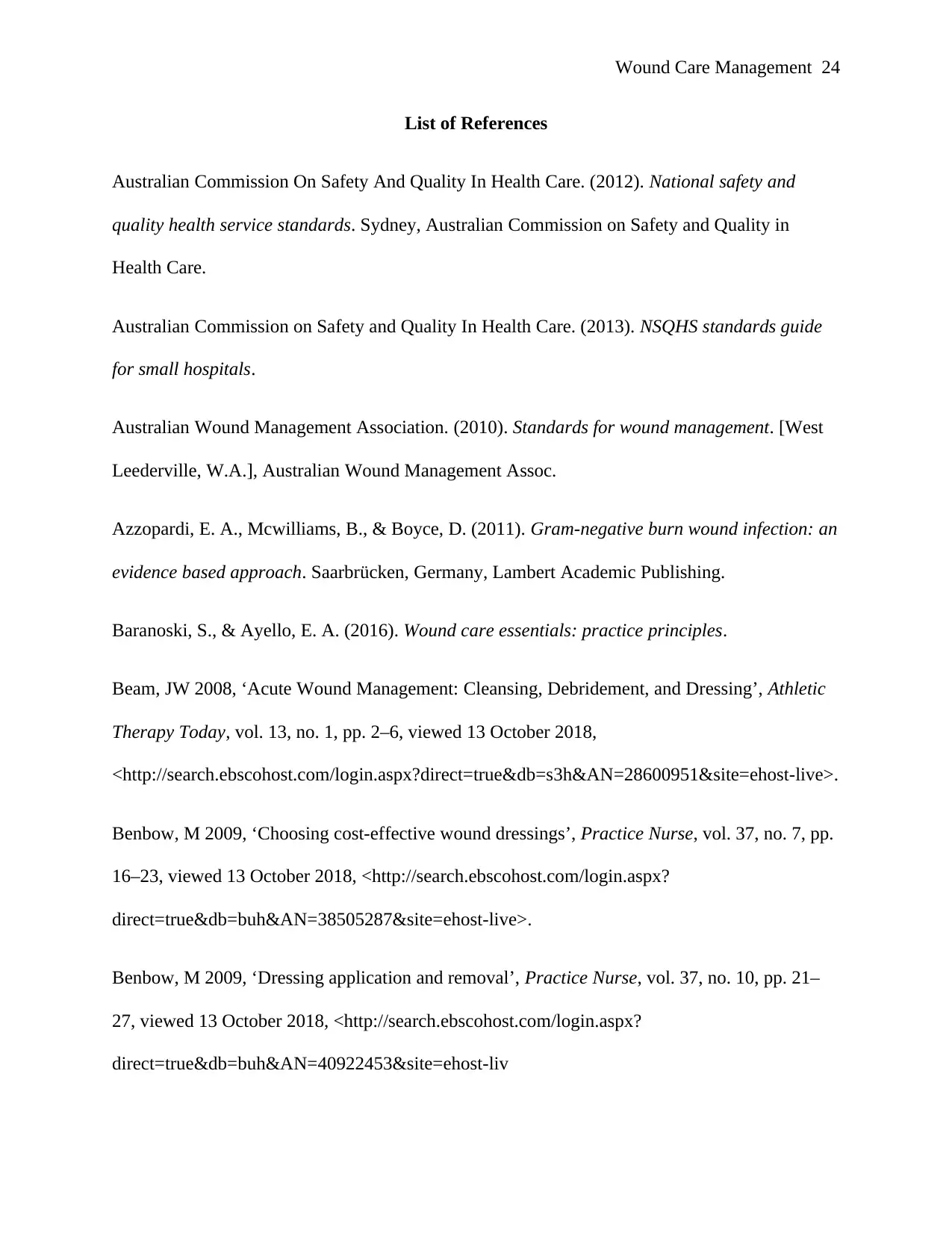
List of References
Australian Commission On Safety And Quality In Health Care. (2012). National safety and
quality health service standards. Sydney, Australian Commission on Safety and Quality in
Health Care.
Australian Commission on Safety and Quality In Health Care. (2013). NSQHS standards guide
for small hospitals.
Australian Wound Management Association. (2010). Standards for wound management. [West
Leederville, W.A.], Australian Wound Management Assoc.
Azzopardi, E. A., Mcwilliams, B., & Boyce, D. (2011). Gram-negative burn wound infection: an
evidence based approach. Saarbrücken, Germany, Lambert Academic Publishing.
Baranoski, S., & Ayello, E. A. (2016). Wound care essentials: practice principles.
Beam, JW 2008, ‘Acute Wound Management: Cleansing, Debridement, and Dressing’, Athletic
Therapy Today, vol. 13, no. 1, pp. 2–6, viewed 13 October 2018,
<http://search.ebscohost.com/login.aspx?direct=true&db=s3h&AN=28600951&site=ehost-live>.
Benbow, M 2009, ‘Choosing cost-effective wound dressings’, Practice Nurse, vol. 37, no. 7, pp.
16–23, viewed 13 October 2018, <http://search.ebscohost.com/login.aspx?
direct=true&db=buh&AN=38505287&site=ehost-live>.
Benbow, M 2009, ‘Dressing application and removal’, Practice Nurse, vol. 37, no. 10, pp. 21–
27, viewed 13 October 2018, <http://search.ebscohost.com/login.aspx?
direct=true&db=buh&AN=40922453&site=ehost-liv
⊘ This is a preview!⊘
Do you want full access?
Subscribe today to unlock all pages.

Trusted by 1+ million students worldwide
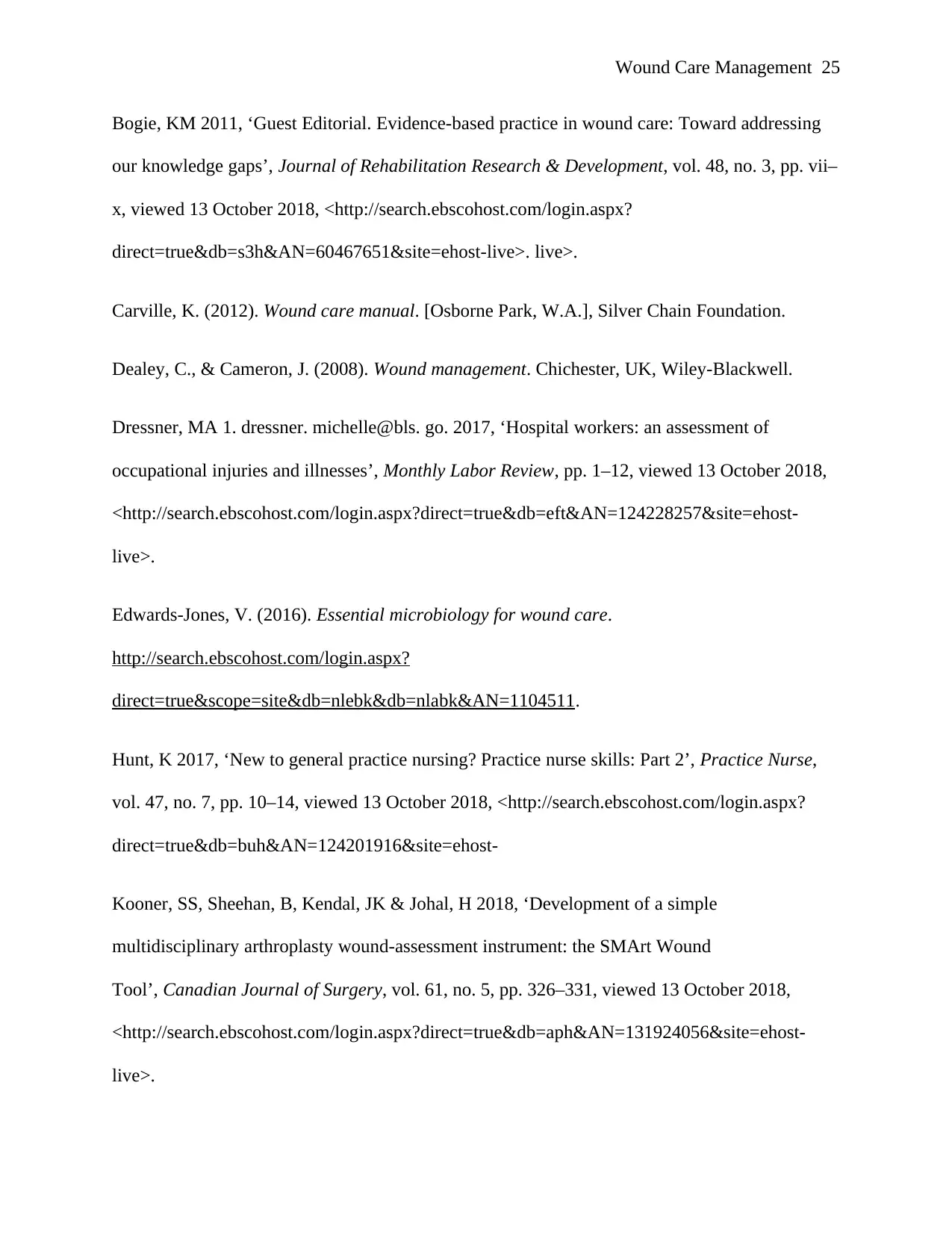
Bogie, KM 2011, ‘Guest Editorial. Evidence-based practice in wound care: Toward addressing
our knowledge gaps’, Journal of Rehabilitation Research & Development, vol. 48, no. 3, pp. vii–
x, viewed 13 October 2018, <http://search.ebscohost.com/login.aspx?
direct=true&db=s3h&AN=60467651&site=ehost-live>. live>.
Carville, K. (2012). Wound care manual. [Osborne Park, W.A.], Silver Chain Foundation.
Dealey, C., & Cameron, J. (2008). Wound management. Chichester, UK, Wiley-Blackwell.
Dressner, MA 1. dressner. michelle@bls. go. 2017, ‘Hospital workers: an assessment of
occupational injuries and illnesses’, Monthly Labor Review, pp. 1–12, viewed 13 October 2018,
<http://search.ebscohost.com/login.aspx?direct=true&db=eft&AN=124228257&site=ehost-
live>.
Edwards-Jones, V. (2016). Essential microbiology for wound care.
http://search.ebscohost.com/login.aspx?
direct=true&scope=site&db=nlebk&db=nlabk&AN=1104511.
Hunt, K 2017, ‘New to general practice nursing? Practice nurse skills: Part 2’, Practice Nurse,
vol. 47, no. 7, pp. 10–14, viewed 13 October 2018, <http://search.ebscohost.com/login.aspx?
direct=true&db=buh&AN=124201916&site=ehost-
Kooner, SS, Sheehan, B, Kendal, JK & Johal, H 2018, ‘Development of a simple
multidisciplinary arthroplasty wound-assessment instrument: the SMArt Wound
Tool’, Canadian Journal of Surgery, vol. 61, no. 5, pp. 326–331, viewed 13 October 2018,
<http://search.ebscohost.com/login.aspx?direct=true&db=aph&AN=131924056&site=ehost-
live>.
Paraphrase This Document
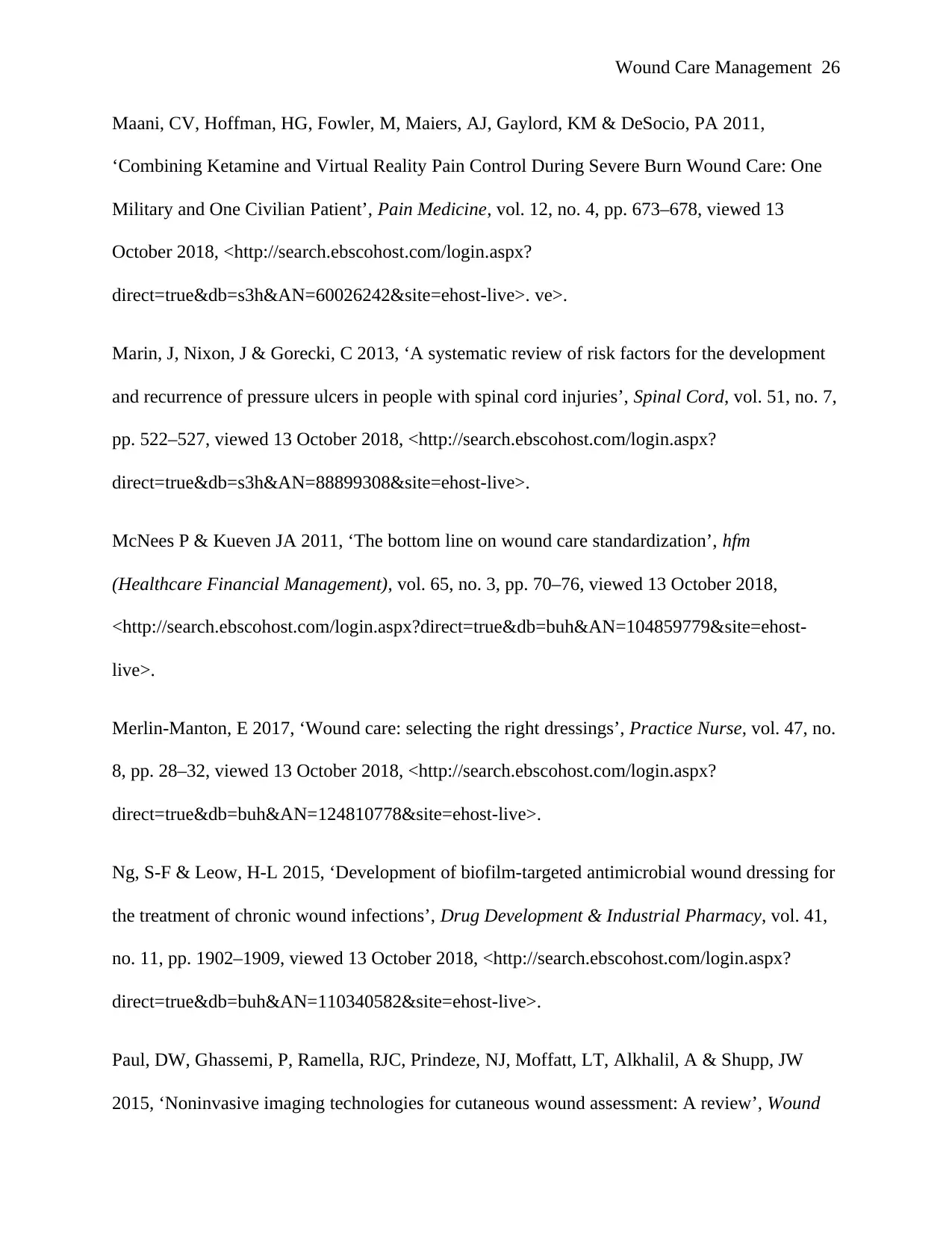
Maani, CV, Hoffman, HG, Fowler, M, Maiers, AJ, Gaylord, KM & DeSocio, PA 2011,
‘Combining Ketamine and Virtual Reality Pain Control During Severe Burn Wound Care: One
Military and One Civilian Patient’, Pain Medicine, vol. 12, no. 4, pp. 673–678, viewed 13
October 2018, <http://search.ebscohost.com/login.aspx?
direct=true&db=s3h&AN=60026242&site=ehost-live>. ve>.
Marin, J, Nixon, J & Gorecki, C 2013, ‘A systematic review of risk factors for the development
and recurrence of pressure ulcers in people with spinal cord injuries’, Spinal Cord, vol. 51, no. 7,
pp. 522–527, viewed 13 October 2018, <http://search.ebscohost.com/login.aspx?
direct=true&db=s3h&AN=88899308&site=ehost-live>.
McNees P & Kueven JA 2011, ‘The bottom line on wound care standardization’, hfm
(Healthcare Financial Management), vol. 65, no. 3, pp. 70–76, viewed 13 October 2018,
<http://search.ebscohost.com/login.aspx?direct=true&db=buh&AN=104859779&site=ehost-
live>.
Merlin-Manton, E 2017, ‘Wound care: selecting the right dressings’, Practice Nurse, vol. 47, no.
8, pp. 28–32, viewed 13 October 2018, <http://search.ebscohost.com/login.aspx?
direct=true&db=buh&AN=124810778&site=ehost-live>.
Ng, S-F & Leow, H-L 2015, ‘Development of biofilm-targeted antimicrobial wound dressing for
the treatment of chronic wound infections’, Drug Development & Industrial Pharmacy, vol. 41,
no. 11, pp. 1902–1909, viewed 13 October 2018, <http://search.ebscohost.com/login.aspx?
direct=true&db=buh&AN=110340582&site=ehost-live>.
Paul, DW, Ghassemi, P, Ramella, RJC, Prindeze, NJ, Moffatt, LT, Alkhalil, A & Shupp, JW
2015, ‘Noninvasive imaging technologies for cutaneous wound assessment: A review’, Wound
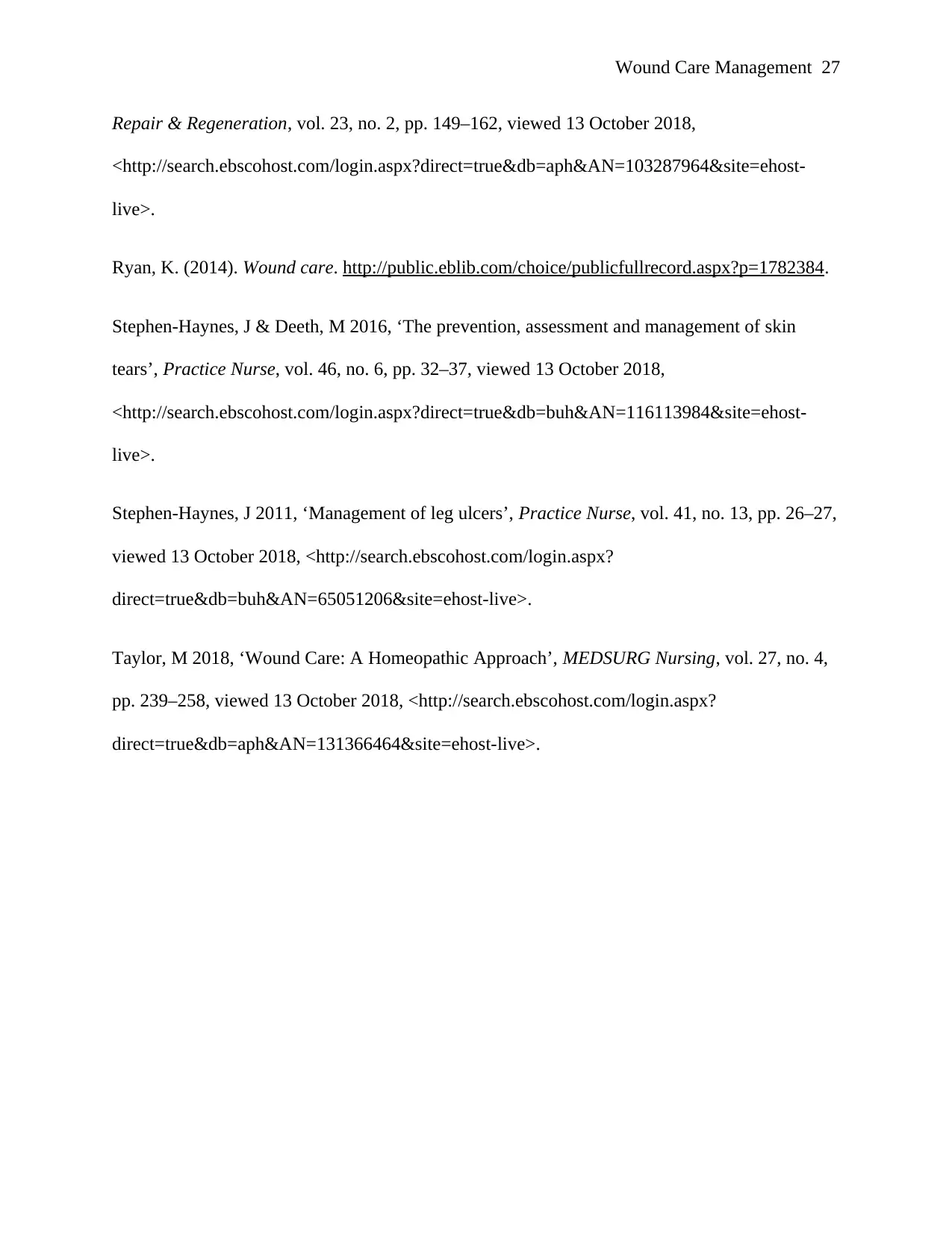
Repair & Regeneration, vol. 23, no. 2, pp. 149–162, viewed 13 October 2018,
<http://search.ebscohost.com/login.aspx?direct=true&db=aph&AN=103287964&site=ehost-
live>.
Ryan, K. (2014). Wound care. http://public.eblib.com/choice/publicfullrecord.aspx?p=1782384.
Stephen-Haynes, J & Deeth, M 2016, ‘The prevention, assessment and management of skin
tears’, Practice Nurse, vol. 46, no. 6, pp. 32–37, viewed 13 October 2018,
<http://search.ebscohost.com/login.aspx?direct=true&db=buh&AN=116113984&site=ehost-
live>.
Stephen-Haynes, J 2011, ‘Management of leg ulcers’, Practice Nurse, vol. 41, no. 13, pp. 26–27,
viewed 13 October 2018, <http://search.ebscohost.com/login.aspx?
direct=true&db=buh&AN=65051206&site=ehost-live>.
Taylor, M 2018, ‘Wound Care: A Homeopathic Approach’, MEDSURG Nursing, vol. 27, no. 4,
pp. 239–258, viewed 13 October 2018, <http://search.ebscohost.com/login.aspx?
direct=true&db=aph&AN=131366464&site=ehost-live>.
⊘ This is a preview!⊘
Do you want full access?
Subscribe today to unlock all pages.

Trusted by 1+ million students worldwide
Related Documents
Your All-in-One AI-Powered Toolkit for Academic Success.
+13062052269
info@desklib.com
Available 24*7 on WhatsApp / Email
![[object Object]](/_next/static/media/star-bottom.7253800d.svg)
© 2024 | Zucol Services PVT LTD | All rights reserved.





